










“This production site is our home but it is also the place where territory and people interact every day. Here is where the products that reach the tables and kitchens of families and of the best restaurants and hotels around the world are born. This is why we feel the responsibility and honor of building an increasingly ethical and sustainable corporate future. Economic success, innovative technologies, efficient management and continuous improvement: not just words, but concrete projects and tangible results. We wish to leave to the next generations a better territory than the one we have found”.
After blowing out the candle for the 10 years of our Sustainability Report, we want to share with you the great work undertaken in the last year with the editorial staff, always on a voluntary basis, of this important and essential document. By adopting ESG reporting principles for the first time we have accompanied the optimization of data collection and processing to a renovation in graphics and in presentation.
The new publication especially corresponds to the desire to tell you about our values, the model of responsibility we follow, the activities and results we have achieved until now. All fundamental issues that flow towards Sustainability. The attention to the environment, the respect and the enhancement of the people and the territory that surrounds us are aspects in which we have invested over the years and which – today more than ever – they have become an integral part of the daily management of the business. At every phase of our production cycle, we follow an efficient energy and environmental policy, we ensure the safety of workers and products and we apply certified management models according to UNI:ISO standards. We believe that thanks to our “virtuous” journey, the company can also gain a real competitive advantage for the future. Combining the highest quality of products with solid reliability in its work.
Despite the complexity of the context, unpredictable and uncertain, we consider 2021 as the year of recovery from the pandemic. We have continued to invest for the future of the company both in social and industrial terms.
We have established scholarships dedicated to young people of the territory. We have introduced new processes and increasingly innovative and efficient machinery. We implemented the first photovoltaic system of our site, so as to guarantee us renewable energy and to improve our environmental performance.
We consider this report a tale where – in total transparency – we show you the evolution and each step that characterizes the constant growth path of Sambonet Paderno Industrie.
Franco Coppo C.E.O.
273
Employees
80 Present in over 80 countries
50% Female executives
96% Permanent contracts
9

67%
8
41%
100
Sambonet Paderno Industrie S.p.A analyzes and examines the corporate context day by day to integrate improvements into all internal processes
Through certified management methodologies, a coordinated and punctual flow, dedicated teams and the constant consulting of accredited bodies, it makes the impact of every choice tangible and it always identifies new improvement goals.
The Company has already achieved numerous goals but every day it is committed to continuous improvements by setting itself new challenges and goals to share with its stakeholders.

SOCIAL RESPONSIBILITY
ENVIRONMENTAL RESPONSIBILITY

QUALITY AND SAFETY OF THE PRODUCT
HEALTH & SAFETY AND WELL-BEING AT WORK
INTERNAL ANALYSIS LABORATORY


Sambonet Paderno Industrie is one of the most important realities of cutlery, tableware, cookware and accessories for the luxury kitchen in Italy, controlled by the families of the brothers Pierluigi and Franco Coppo through the Arcturus Group holding.
With more than a century of history behind them, Sambonet and Paderno, the two souls of the Company, represent the best practices of the sector serving both the Horeca sector and final consumers.
The attention to the quality of the product combined with a strong interest in its aesthetics, have made the two brands of the Company, Sambonet and Paderno, award-winning and internationally recognized brands
Sambonet Paderno carries out its activities in a production site which rises in an area of 110,000 square meters with an eco-friendly architecture, harmoniously inserted in nature, between Vercelli and Novara.
The Vision of Arcturus Group Inspire and enhance every positive experience in the kitchen, at the table and in the home living.
In continuous search for uniqueness, it has always paid great craftsmanship attention to details while maintaining a constant balance between tradition and innovation. In fact, since the early 60s it boasts important collaborations with the greatest designers on the market, including Gio Ponti, Anna Castelli Ferrieri, Rodolfo Dordoni, Stefania Vasques and many others, who affirm and spread their design orientation.
Always focused on the creation of products of excellent quality, it is a point of reference for professionals in the culinary sector. In fact, the brand offers a wide range of pots and other tools that guarantee the best performance in the kitchen, suited to the precious needs and refined techniques of internationally renowned chefs.


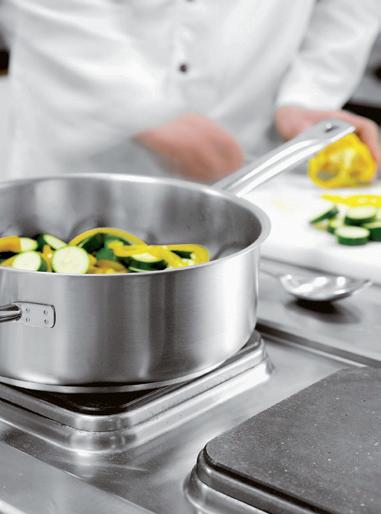

The entire site has been imagined, as a whole, as a design object integrated within the context of the Piedmont countryside. The plant project, followed by the Frigerio Design Group studio, has been able to harmonize forms and functions with the image of the surrounding territory characterized, in some ways, by great contradictions: pervaded on one side by the rhythms of production and trade, but on the other side, marked by the secular rhythms of the agricultural world.
The culture and traditions that distinguish the surrounding area become the inspiring elements of the architectural project, which precisely arises from the recognition of the peculiar and constitutive characteristics of the surrounding landscape: from the geometries of the road layouts to the subdivision of patches of paddy field according to Cartesian forms, to the courses of irrigation channels.
The large green spaces have allowed to rationally organize the internal and external spaces, while at the same time opening major prospects for architecture experimentation and for the innovative use of building materials.
The surrounding spaces have allowed to imagine a site that develops horizontally: a large container with a highly technological appearance whose facades assume the function of a real grilled screen, a border between open spaces and the world of production and sales, separated by thin limits made up of the glass walls.
The plant has been designed as a single floor to facilitate internal circulation as much as possible, while the showrooms and offices are articulated on two floors; in particular, the technical offices related to production are located on the first floor immediately above the production plant to be directly in contact with the production lines. The window, which is 100 meters long and 8 meters high, projects the offices outwards by day, while at night it discovers the activities it contains. Instead, on the facades of the sheds a grit finish recalls the worked metals with its glossy appearance.
Finally, to design the greenery, the typical rural elements of the area were used, such as flat green meadows like rice fields and rows of cypress poplars, natural landscapes that define borders or paths.
We perceive in every place the concrete echo of a unique and unrepeatable story: we are able to take the good that the context offers spontaneously, its variety of stimuli and inspirations, its resources: culture, climate, atmospheres, lights, materials including scraps, even shards, because – as Japanese art 'kintsugi' of repairing with gold teaches - each crock has broken in its own way, transmitting a story to be valued. This raw material, available effortlessly, is the fuel with which we feed ideas and design solutions for the success of a unique and unrepeatable architecture, which can build a bridge between tradition and innovation".
“We are committed to not leaving footprints: we want to reduce the ecological footprint and make more coherent and conscious use of materials and resources. To do so we follow the lesson provided by nature in whose circular processes nothing is wasted, and by the past. We aim to be sustainable from the outset. Because the energy consumption of the building is only the final phase of a process that has already started from the energy used in the production of the architectural pieces and components that we have chosen to use".

Undoubtedly the distinctive trait in Sambonet's work and design is given by its autonomy in realization, from the concept and the design phase to the production phase, thus giving all products a clear connotation of craftsmanship: 90% of the products are in fact signed by the style center of the company. This has always helped to strengthen the brand identity, making it exclusive and unmistakable in the international panorama.
Collaborations with renowned external designers are linked to specific projects and enrich the wide "home-made" offer.
Each Sambonet product is a unique design work, where originality and craftsmanship are combined with technical innovation. Each piece comes from a solid Italian tradition and is made using the best materials and with a marked orientation to excellence. The consolidated know-how allows to propose on the market exclusive products that stand out for the unique and award-winning design signed Sambonet, which today boasts 500 international awards.
An example is the Pesciera designed by Roberto Sambonet, winner of the Compasso d'Oro in 1970 and currently in the collection at the MoMA in New York. Entirely in stainless steel, it is an expression of a refined masterpiece of design and engineering, difficult to imitate because of the complexity of steel stamping. The various collaborations - to date about 400 - with some of the most important designers and architects in the world make the brand even more unique and prestigious.

Each author's project that has collaborated with Sambonet reflects the ambition to achieve formal and functional qualities of excellence

In 2013, the collaboration between Sambonet and the Master of design Gio Ponti gave life to the project Centrotavola, which was immediately awarded with the most prestigious international awards.



Among the most important names of the artists who have collaborated with Sambonet is also that of Anna Castelli Ferrieri, architect and industrial designer of international renown, whose project, Hannah, won the prestigious Compasso d'Oro ADI 1994 award.




OUR VALUES AND OUR HISTORY
The company originates from the Officine Meccaniche Giovanni Coppo firm, born in 1978 in Milan. The brothers Pierluigi and Franco Coppo started an entrepreneurial success story with the acquisition, in 1979, of Paderno, a Group founded in 1925 in Milan, a world reference point for professional cookware, and in 1997 of Sambonet, a historic Piedmontese company of cutlery and pottery, founded in Vercelli on 15 May, 1856 by Giuseppe Sambonet, goldsmith and graduate from the Institute of Fine Arts.
Between 1997 and 1999 the new headquarters was built, an ecocompatible architecture, harmoniously inserted in nature, designed by the architect Enrico Frigerio based in Novara
In November 2004 the two brands merged and the company changed its name to "Sambonet Paderno Industrie".
Since 2005, Sambonet Paderno Industrie has undertaken a path of acquisition of certifications in different fields, which highlight a growing attention to ESG issues.
In 2006 the company received the Confindustria Awards for Excellence from Confindustria, an honorific created to reward excellent companies that have distinguished themselves in Made in Italy, innovation and enhancement of the territory.
This acquisition, together with the skills acquired by Sambonet in the hospitality industry, marked a fundamental point in the international development of the Group, guaranteeing it a leading role in the table top Home, Ho.Re.Ca. and Contract.
The portfolio of the Holding Arcturus Group, parent company of Sambonet Paderno Industrie S.p.A , expanded in 2013 with the acquisition of the German porcelain brand Arzberg and in 2015 with the acquisition of the historic French porcelain excellences of Limoges Raynaud and Ercuis silver cutlery.
The result of this corporate strategy, aimed at growth and acquisitions, is the establishment of a leading reality in terms of quality, diversification and complementarity of the table and kitchen offer, which ranges from medium-high level to extreme luxury thanks to the different identities of its brands.

Sambonet Paderno Industrie, present in over 30 countries, mainly Italy, Germany and United States, offers its high quality and refined products to a wide range of players.

The company’s main customers are companies or third-party resellers. In particular:
• Resellers: the company is a partner of numerous shops and retail businesses of cutlery, cookware and more generally tools for the kitchen and table of high level. In fact, the "target segment" of final consumers has always been that of passionate characters about the world of refined cuisine;
• Ho.Re.Ca (Hôtellerie-Restaurant-Café): the Company provides its products to many hotel chains, hotels, restaurants and cafés around the world.
• Third party e-commerce: the Company makes its products accessible through third-party e-commerce, the biggest partner is certainly Amazon;
Sambonet Paderno also reaches final consumers through its own e-commerce and outlet in Novara.
The Company is careful to satisfy the needs of each category of consumers and customers: from hotels, to restaurants, to customers reached through e-commerce/specialized retailers, Sambonet respects their expectations and needs through the wide range of products of the two brands.
% Third-party e-commerce

Sambonet, an international leader in the production of cutlery and crockery in stainless steel, silverplated stainless steel and galvanic nickel, is more or less equally divided between the HORECA and retail sectors. In addition to the tableware line, Sambonet has recently introduced "Sambonet Luxury", with a refined selection of high-quality products and "Sambonet Kitchen Collection", a youthful series that aims to enter the world of cooking.


Paderno operates mainly in the hotel sector and it stands out for its cookware for professionals, in stainless steel, copper, aluminium, iron and enamelled cast iron. The brand also offers over 10,000 items dedicated to chefs and gourmet enthusiasts: knives and other tools for recreating cutting-edge kitchens.
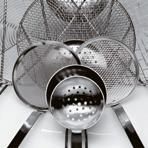







 CUTTLERY TABLE
CUTTLERY TABLE
Arthur Krupp, thanks to extremely resistant and elegant porcelain, high-quality stainless-steel cutlery and a wide selection of tableware, meets every need of professional catering. The completeness of the offer, combined with the excellence of the workmanship and the perfect shapes for every type of table, make the brand a leader in the world of professional food service and hotel industry.





 CHINA AND BONECHINA
COFFEE AND TEA
CHINA AND BONECHINA
COFFEE AND TEA
Fairness and transparency are the basis of the Group's decision-making and operational process. In fact, Sambonet Paderno Industrie has always pursued the achievement of its corporate goals through activities carried out in compliance with the law and fundamental human rights, and it has also always imposed itself clear and transparent rules, in harmony with the purposes of its bearers of value.
In 2015, the actions described above were formalized in the first edition of the Company's Code of Ethics, a set of fundamental guidelines that inspire the Company's activities and guide the behaviors of its Employees and of all other thirdparty interlocutors for the proper functioning, reliability and image of the Company itself
In this framework, Sambonet pays particular attention to the human factor: people are the main reference point of everything that is done. Sambonet promotes the enhancement and the professionalism of the staff, which is an indispensable factor for the Company’s success, in particular ensuring maximum compliance with the regulations on safety and health at work, reason for which it is has obtained first OHSAS 18001 certification and later UNI EN ISO 45001
FAIRNESS AND TRANSPARENCY
The attention that the Company shows towards its Employees and external Customers is supported by the numerous certifications that have been achieved over the years. In particular, the Company is certified according to UNI EN ISO 9001, quality management systems, UNI EN ISO 14001, environmental management systems, UNI EN ISO 50001, energy management systems, UNI EN ISO 22000, food safety management systems and it has implemented within it an analysis laboratory accredited UNI EN ISO 17025, to provide an additional direct guarantee to the final customer by carrying out more frequent tests on its products.
The company has adopted an integrated policy suited to the size and activity of the organization, aimed at the continuous improvement of environmental performance and prevention of pollution. This policy has been integrated by adopting schemes concerning quality, the environment, worker safety, energy and food safety. Signed by the management, it was communicated to all Employees by posting it on the company bulletin boards and published on the company website.
IMPARTIALITY
TECHNOLOGICAL
Sambonet is aware that social responsibility is today a concept stated in the economic, environmental and social debate, and believes that it is a useful concept for the progress of society, therefore, the Company set its own behaviour and conduct in accordance with internationally recognised principles of social responsibility, obtaining the certification according to the SR10 scheme.
Social responsibility is integrated with the entire decision-making and operational process, taking into account all its dimensions: social, economic and environmental.
Starting from the end of November 2021, the Company has adopted its own Organization, Management and Control Model pursuant to Legislative Decree 231/01 (hereinafter Model 231 or M.O.G.) for the management of environmental risks and those related to the health and safety of the individual.
This initiative was taken in the belief that the adoption of the Model can be a valid tool for raising awareness among all those who work in the name and on behalf of the company, so that they adopt correct and linear behavior in carrying out their activities, such as to prevent risk of committing the offenses provided for by the Decree itself. In particular, through the adoption of the Model, the company aims to pursue a thorough and periodic monitoring of the areas of activities at risk and to intervene promptly to prevent or counter the carrying out of the crimes themselves.
The Organizational Model, however, has been completed with the establishment of a Supervisory Body that, as required by the Article 6 of Legislative Decree n.231/2001, has the function of overseeing the functioning, effectiveness and compliance with the Organizational Model, taking care of its constant updating.
During the year 2022 specific training sessions on the Model and the application of the Code of Ethics will be provided to all Sambonet employees, from blue-collars to executives, in order to spread the culture of Ethics and at the same time of Compliance within the Company.
zero
Confirmed corruption incidents in 2021
zero
Lawsuits for anti-competitive behavior, antitrust and monopolistic practices in 2021
zero
N° of episodes of monetary and/or non-monetary sanctions for non-compliance with environmental/social laws or regulations
Despite the persistence of the pandemic emergency Covid-19, from the beginning of the year 2021 the international scenario has been characterized by an economic recovery higher than expected
The 2021 Financial Statements for Sambonet Paderno Industrie closed with revenues from sales and services of 65,550,392 euros, recording an increase of 36% compared to the previous year and 17% compared to 2019 (pre-Covid year). Furthermore, expectations on the future evolution of management are positive in relation to the trend observed in 2021 and the good prospects for 2022, supported by a high set of orders.
The prospectus of the distribution of the economic value generated expresses, in monetary terms, the relationship between Sambonet and the socio-economic system of reference, measuring its ability to create and distribute wealth among its main stakeholders as suppliers, employees, public administration, investors and local communities.
The company is committed to responsible and aware distribution of the value it creates through its business activities. The table below shows the portions of economic value distributed to the various bearers of value of the Company, identified by reclassification of the profit and loss account.
In 2021, the economic value generated amounted to about 66,852 million euros, while that distributed amounted to about 57,205.
Distributed to capital providers Distributed to the Public Administration
75%
1% 2% Distributed to employees
In general, the largest share of the total value distributed was distributed to the Suppliers category, for a total of 75%: the item includes the purchases of raw materials and other operating costs such as goods and services, third-party assets and management costs.
The other category to which a significant share has been distributed are the Employees, to whom through wages and salaries, severance pay, social charges, various benefits and other personnel costs was distributed about 22% of the total value distributed.
The remainder of the distributed value, a total of about 3%, is allocated to Capital Suppliers, the Public Administration, through the payment of current fees and other various taxes and to local communities for which the Company has registered donations, including one towards Ared.N.G.S.A. Onlus and another for the restoration of a church located in the Municipality of Orfengo.1
Sambonet has always been committed to supporting local communities; the bond between society and the surrounding territory has always been marked by initiatives, donations and other activities that the Company have involved with.
For the Company it is essential to maintain an active relationship with students, as a way to promote the possibility of passing on to new generations the art of Italian craftsmanship, as well as a way to encourage the exchange of skills between the educational world and the industrial one, through educational paths that respond to the work needs of today and that train specialized personnel.
Always with the same goal of addressing young talents, the Company has joined a network of companies that allows children in neighboring areas to have school-work experiences. In this context, Sambonet also gives the possibility to its employees' children to carry out their first work experience to preserve and pass on their know-how in the manufacture of cutlery and cookware.
Sambonet Paderno’s involvement in local communities is not only limited to the world of education, but also extends to support and proximity to citizens (about 80% of Sambonet employees are residents of the areas Vercelli and Novara) and associations, municipalities and other public institutions. The Company, which considers of fundamental importance to establish virtuous relationships with the social fabric of the territory, has consolidated stable relationships with realities such as Confindustria Novara Vercelli Valsesia, ANIMA Confindustria meccanica. Federation of European manufacturers of Cookware and cutlery – FEC, Association of Italian manufacturers of household, tableware and similar items - FIAC.
Some initiatives that have characterized the involvement of Sambonet in the local community during the year 2020 and 2021 are listed below.
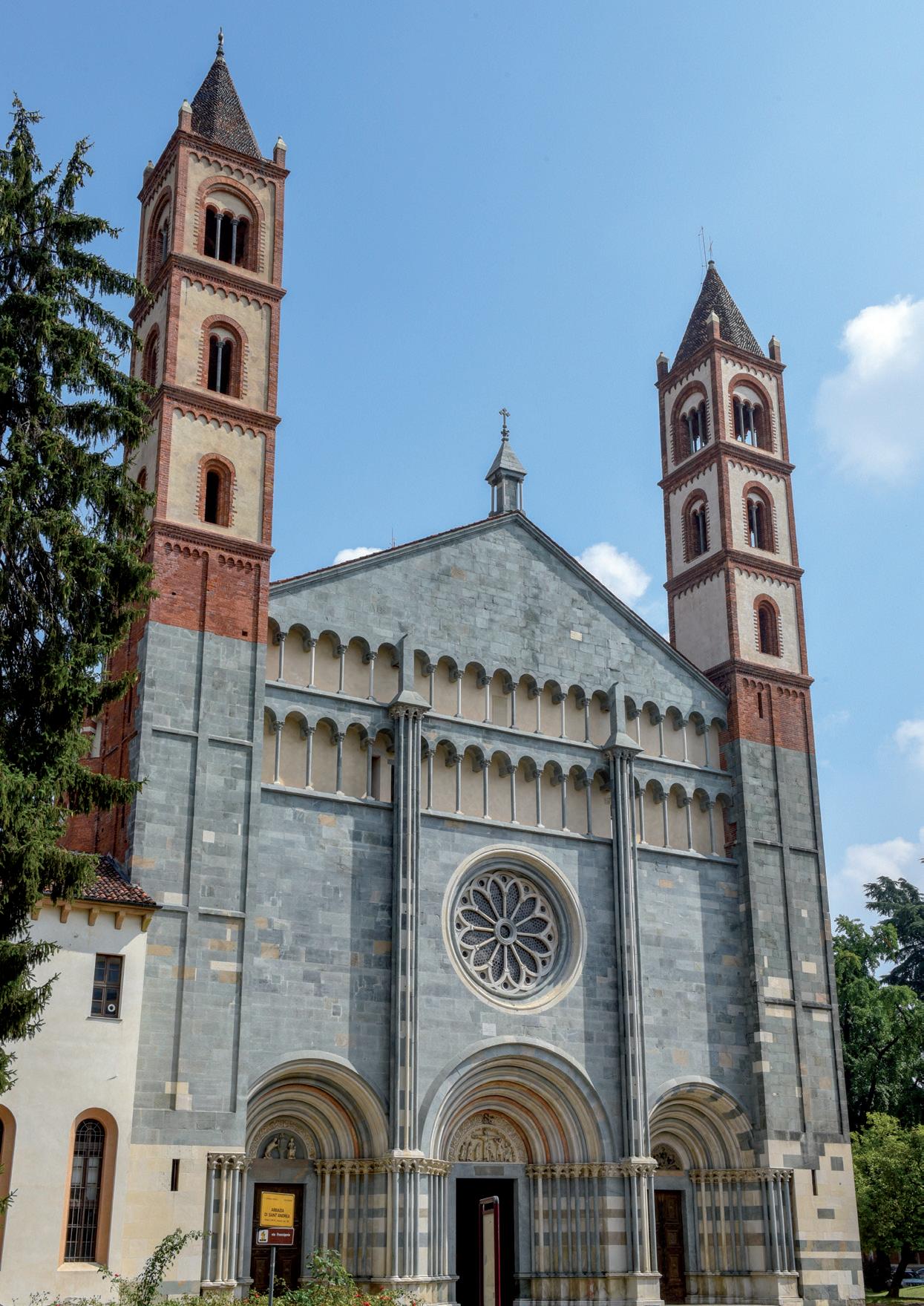
Sambonet has made available twelve scholarships "Maria Valentina Francia", for a total of 25 thousand euros, for the school year 2021-2022. This funding is dedicated to the mother of the Company owners, spokesperson for the centrality of school and study.
The project under scope aims to enhance the qualified training courses in the mechanical and electronic field of technical institutes Giuseppe Omar of Novara, Giulio Cesare Faccio of Vercelli and for the Institute Ascanio Sobrero of Casale Monferrato. The scholarship includes a prize of 3

thousand euros that is awarded in a completely meritocratic way to the best graduate of each technical institute regardless of the gender or course of study completed. In addition, for particularly meritorious females attending the biennium, addressed to the sections of mechanics, electrical engineering and electronics, Sambonet Paderno Industrie has made available an encouraging incentive: three scholarships of 1,5 thousand euros in order to enhance the role and excellence of women within a technical training path, culturally still perceived as a male path.

In 2020 the Company was recognized as a Solidarity Taxpayer during the pandemic period by the Ministry of Economy and Finance: while having the opportunity to postpone payments of its taxes (as required by the Cura Italia Decree), Sambonet waived this condition by regularly paying its contributions in an extremely complex period
Thanks to taxpayers like Sambonet, there was an important support for the Italian economy and for the productive and health-care effort of the country in that difficult period. For these reasons, the State has decided to give this recognition to taxpayers who have proved to be particularly responsible at the social level.

Sambonet supported a project of the "the Poppio" club to raise awareness of the issue of plastic in the surrounding municipalities. The project, that has started in November 2021 and is expected to end in late 2022, aims to promote environmentally sustainable behavior.
This initiative presupposes an analysis of the types of plastic products used in offices and public places to identify possible alternatives and corrective actions, taking into account the standards of Green Public Procurement (GPP) and the Minimum Environmental Criteria (CAM)
To demonstrate Sambonet’s commitment to the Novara area, the Company has been involved in a project of restoration and conservative rehabilitation of the environment of the Sacristy on which stands the "Wall of Saints" in the Chapel of the Annunciation, adjacent to the Parish Church

of SS.Pietro and Paolo of Casalino. Rediscovered in September 1995, during some reorganization works, the cycle of frescoes needs urgent intervention because it is in a critical condition and deserves a restoration that enhances the historical and artistic importance.
Responding to Confindustria's appeal, in April 2021 Sambonet made available its headquarters in Orfengo, in the province of Novara, as a point of administration of vaccines against Covid-19, both for its collaborators and for their families and the territory
The sole director of the Company, Franco Coppo, declared about that: "We wish to play an active part by giving our contribution to speed up this indispensable campaign, a valuable fight against the time to achieve a total coverage of the population".
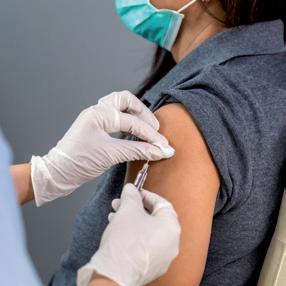


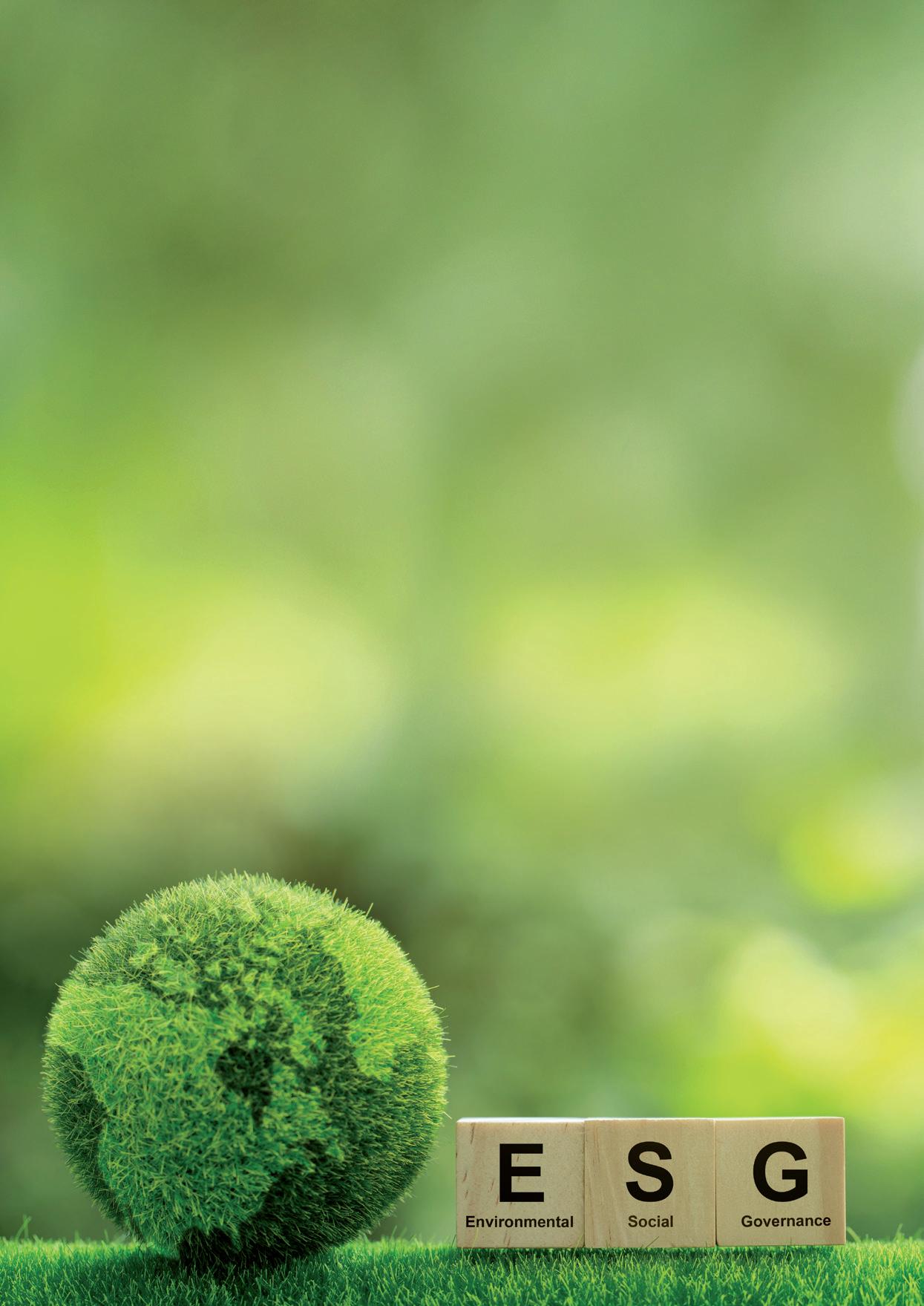
Sambonet Paderno Industrie has consolidated and increasingly strengthened over the years its commitment to the integration of the principles of environmental, social and ethical sustainability in every business activity. Sustainability, transparency and awareness are the key words of the Company’s way of acting. This approach has guided the industrial growth of recent years, growth accompanied by the implementation of a responsible, sustainable and respectful policy towards people and the territory.
The testimony of a totally transparent and ethical conduct is represented by the achievement of numerous certifications, some of them completely
voluntary, as well as the implementation of modus operandi able to guarantee the quality of its work.
Since 2016, Sambonet boasts a management model on Social Responsibility because it is certified SR 10 IQNet SR 10 is an international standard that allows to integrate social responsibility in the organization’s strategy and to communicate the results achieved through the achievement of the certification.
Sambonet’s commitment to ESG issues is expressed in the promotion of a corporate culture focused on:

• respect and enhancement of people
• environmental protection and safeguard
• enhancement of the entire production chain
• support to the local community in which the Company operates
• transparency and ethics
The company is deeply aware of the growing importance of sustainability for the market, as well as the responsibility to manage and mitigate the impacts of business activities on the territory in which it operates.
The results of the management of Sambonet Paderno, increasingly attentive to sustainability, have also been confirmed by the rating received by EcoVadis, one of the most important international platforms for eco-sustainability rating. In this context, in fact, the Company has been evaluated in several areas (environment, work and human rights, ethics and sustainable purchasing), and has positioned itself in the 92nd percentile of the production of cutlery, hand tools and hardware in general, namely demonstrating an alignment with benchmark companies of the sector.
An important step for the Company towards Sustainability has been realized during this year through the publication of its first Sustainability Report prepared according to GRI Standards This document, in fact, has relevance because it represents the desire to achieve levels of transparency and accuracy of the data involved increasingly accurate. The tool aims to increase communication both towards the actions already implemented and towards future objectives.
Finally, the publication of this document allowed Sambonet to carry on, for the first time, an in-depth analysis, through which both the most important categories of Stakeholders have been identified, and the relevant issues within which their positive and negative impacts in terms of sustainability are manifested.
10 YEARS OF SUSTAINABILITY REPORT
PAPER REDUCTION AND DIGITAL ARCHIVING
MONITORING OF CONSUMPTION AND DISCHARGES
WELL-BEING OF EMPLOYEES AND ATTENTION TO THE TERRITORY
USE OF RECYCLABLE MATERIALS AND WASTE REDUCTION
In carrying out its activity, the Company comes into contact with a multitude of stakeholder categories, which are all those actors directly and/or indirectly influenced by the activities of the organization, or who actively influence its work.
In reference to the sustainability process undertaken, the stakeholders represent key interlocutors with whom Sambonet is absolutely transparent: the Company is committed to their involvement and inclusion of their priorities and perceptions within the definition of the corporate strategy.
Thanks to the requirements pursued over the years in the field of Corporate Social Responsibility and the commitment required also to suppliers and
intermediaries with whom Sambonet Paderno Industrie collaborates internationally, the Company is now able to offer objective guarantees to the various categories of interlocutors, from employees, to customers, to the market, to the community, to bodies and institutions.

A more exhaustive overview of the Stakeholder categories with which Sambonet Paderno Industrie Spa interacts frequently is provided below.
CUSTOMERS
FINAL CONSUMERS
SUPPLIERS
PROPERTY
EMPLOYEES TRADE UNIONS
ASSOCIATIONS AND NGOS
MEDIA
LOCAL COMMUNITIES
INVESTORS AND BANKS GOVERNMENT ENTITIES, INSTITUTIONS AND PUBLIC ADMINISTRATION
PARTNERS
SCHOOLS, UNIVERSITIES AND RESEARCH CENTERS
The involvement of the identified interlocutors takes place mostly within the framework of normal business activities and is based on a constant and transparent communication that allows to establish a constructive dialogue.
The following table summarizes the main ways of involvement for each category of Stakeholder:
B2B CUSTOMERS
FINAL CONSUMERS
Press reviews, social media, website, questionnaires, online and offline advertising, publications (price lists, catalogues, etc.), PoS materials, newsletters, conferences/visits and factory tours, sector fairs and roadshows.
Social media, website, questionnaires, online and offline advertising, publications (brochures, catalogues, etc.), PoS materials, newsletters.
SUPPLIERS
PROPERTY
EMPLOYEES
INVESTORS AND BANKS
LOCAL COMMUNITIES
Website, conferences/visits.
Press releases, press reviews, website, internal meetings.
Press reviews, social media, website, questionnaires, newsletters or internal emails, company bulletin boards, internal meetings.
Press releases, website, meetings and gatherings.
Website, online and offline advertising, conferences/visits and Open Day.
Website, conferences/visits and Open Days, Scholarships. AND RESEARCH CENTERS
SCHOOLS, UNIVERSITIES
ASSOCIATIONS AND NGOs
TRADE UNIONS
Website.
Newsletters, corporate bulletin boards, conferences/visits and Open Days, internal meetings.
Website. AND PUBLIC ADMINISTRATION
GOVERNMENT ENTITIES, INSTITUTIONS
PARTNERS Website, publications (price lists, catalogues, education or training, sector fairs and roadshows).
MEDIA
Social media, website, publications (price lists, catalogues), sector fairs and Roadshows.
The materiality assessment is the tool used to define "material" issues, which are those aspects of economic, social and environmental responsibility that are important for both the Company and its Stakeholders, shown in the Sustainability Report. The "material" topics are therefore able to influence both the corporate strategy of the organization and the opinions and assessments of its stakeholders.
The process of defining these issues was divided into two phases:
PHASE
In the first phase, Sambonet Paderno Industrie has mapped the potential material issues through benchmarking surveys of relevant issues to the cutlery and cookware sector.
PHASE
The second phase envisaged the organization of a Workshop with the management of the Company, where the main corporate functions such as R&D, Production, Human Resources, Purchasing, Marketing and Communication were involved. The involvement of the leaders of several business areas has ensured exhaustiveness of judgment, allowing the Company to consider different perspectives and priorities depending on the activity of each department and function involved.
In particular, the participants were asked to assess the current and prospective relevance of themes proposed from two perspectives:
• The point of view of the organization
• the point of view of Stakeholders, acting as spokespersons for them, to establish how the issue had the ability to influence their decision-making process.
The result of this analysis is represented in the first matrix of materiality of Sambonet Paderno Industrie, graph shown below, which offers a summary of the topics that have priority for the organization, crossing them with the level of interest they have for their interlocutors.
Governance, Ethics and Integrity
Economic responsibility
Product responsibility
Environmental responsibility
Social responsibility
Responsibility towards personnel
Relevance for stakeholders
Research, development and product and process innovations
Compliance and Risk Management
Sustainable packaging
Protection of the territory and development of local Communities
Responsible sourcing
Diversity, Inclusion and Protection of Human Rights
Enhancement and wellbeing of people
Customer satisfaction
Value creation
Quality, sustainability and product safety
Workers' health and safety
Energy management and climate change
Waste management and circular economy
Corporate Governance
Management of water resources
Relevance for Sambonet
The results of the vote led to the identification of 15 material issues:
GOVERNANCE
COMPLIANCE AND RISK MANAGEMENT
Definition of a governance structure that includes criteria of social and environmental responsibility. Transparent communication on the organization’s good governance practices and adherence to international best practices/regulations.
Integrity and transparency in business activity that includes the adoption of a Code of Ethics, policies and procedures to support compliance with current regulations. Adherence to national and international principles and guidelines that include areas of social and environmental responsibility. Identification, assessment and management of present and potential economic, social and environmental risks to which Sambonet is exposed.
VALUE CREATION
Ability of the Group to create and distribute value between the different categories of stakeholders. Pursue economic and financial results and ensure socio-economic and environmental balance in medium-long term.
RESEARCH, DEVELOPMENT AND PRODUCT Research and development activities aimed at the design AND PROCESS INNOVATIONS of innovative and more sustainable products, with particular attention to the integration of new technologies in production, or the continuous improvement of processes.
QUALITY, SUSTAINABILITY AND
Development of products and services that comply with PRODUCT SAFETY high quality and safety criteria aligned with national and international standards and industry best practices.
CUSTOMER SATISFACTION
Offering products and services that meet customer needs and monitoring their degree of satisfaction to pursue continuous improvement.
Support to local communities through sponsorships, DEVELOPMENT OF LOCAL COMMUNITIES donations and partnerships aimed at creating a sustainable and cultural development in the areas close to the reality of Sambonet (Province of Novara and Vercelli). Promotion of the conservation and/or creation of habitats conducive to the maintenance of native flora and fauna.
TERRITORIAL PROTECTION AND
RESPONSIBLE SOURCING
Selection and monitoring of suppliers according to social and environmental criteria and promotion of social responsibility behaviour also through selection of certified raw materials.
Reduction of carbon dioxide emissions and compensation of CLIMATE CHANGE those that cannot be eliminated. Focus on energy efficiency and the use of renewable energy sources.
ENERGY MANAGEMENT AND
MANAGEMENT OF WATER RESOURCES Conscious and efficient management of water resources and definition of efficiency strategies in water use. Monitoring practices for the chemical, physical and biological quality of discharges.
SUSTAINABLE PACKAGING
Attention to the sustainability of product packaging, to minimize non-recyclable materials, promote the recovery of materials and prefer the compostable and biodegradable, derived from plant products (for example tissue paper or Kraft paper without plasticization).
Responsible management of waste related to business CIRCULAR ECONOMY activities. Promotion of circular economy activities and waste recovery.
WASTE MANAGEMENT AND
WORKERS' HEALTH AND SAFETY Policies, procedures and management systems that promote the protection of health and safety in the workplace in full compliance with the related regulatory requirements, which also include periodic monitoring activities.
ENHANCEMENT AND WELL-BEING
Promotion of initiatives to improve the well-being of OF STAFF employees and the right balance between private and working life. Ensure learning and training paths to improve employee skills and attract talent.
DIVERSITY, INCLUSION AND PROTECTION
Promotion of equal opportunities through the development OF HUMAN AND WORKERS' RIGHTS of inclusion policies and the enhancement of diversity. Ensuring respect for human rights for all people involved, through Code of Ethics, Management Systems and adhesions to international charters and principles.



It is thanks to the skills of the employees, the quality of the raw material and the increasingly innovative production process that Sambonet produces excellent products.
Sambonet is aware of how these factors influence the success of the Company and every day tries to invest in its people, in responsible procurement and in the continuous efficiency and modernization of its production process.
Sambonet is fully aware of the strategic role that its people have in the success of the Company and the valuable contribution that they make day after day.
For this reason, the Company values and protects the human heritage from many points of view, encouraging the inclusion of young people into the world of work, ensuring equal opportunities and respecting the great value of diversity, in all its facets.
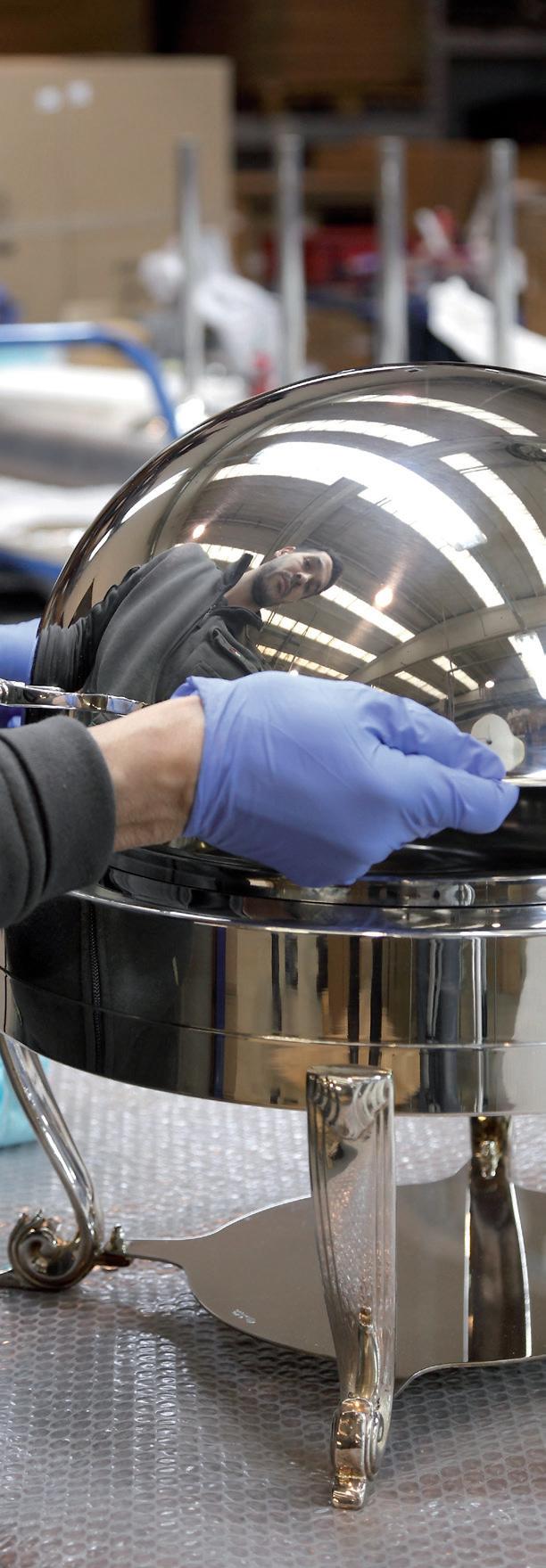
Selecting staff on the basis of CRITERIA OF OBJECTIVITY, COMPETENCE AND PROFESSIONALISM, ensuring equal opportunities and avoiding any favoritism and aiming to ensure that the Company has the best skills in the job market.
Maintaining an internal environment that PROMOTES THE INVOLVEMENT OF THE STAFF in the achievement of the organization’s objectives
COMBATING FORCED AND CHILD LABOUR
CREATING A SAFE WORKING ENVIRONMENT
in accordance with national and international directives on the matter and with the voluntary standard UNI EN ISO 45001.
Complying with the REQUIREMENTS ON CONFIDENTIALITY of personal data contained in the Data Protection Code in accordance to EU Regulation 2016/679.

of unionisation and of collective representation.
Establishing a REMUNERATION POLICY that supports a dignified lifestyle.

Respecting all SOCIAL PROTECTION RIGHTS
(sickness and accident, pension, unemployment insurance, etc.), to protect the stability and quality of jobs.
Investing IN UPDATING KNOWLEDGE AND SKILLS
that could improve their career prospects and productivity as well as the competitiveness of the organization.
Aiming for AN ADEQUATE WORK-LIFE BALANCE.
Encouraging RESPECT FOR HUMAN DIGNITY.
The attention to the staff begins the same day you become part of the Sambonet Paderno family, in fact, during 2021, the Company has drawn up a "Welcome Book", structured document that from 2022 will be provided to all new hires with the aim of making the on-boarding and integration process more fluid and effective in the company. In fact, with this document, the new entry immediately gets to know the values, practices and policies of the Company Within the Welcome Book, in fact, there are the most important information in this field, such as the rules of conduct in the Company, the values described in the code of ethics, the procedures for safety and prevention, the presentation of the existing certifications and management systems that characterize the path towards sustainability at 360°
273 employees Company headcount on 31 December 2021
increased compared to 2020, where it was 261.

During the reporting year Sambonet recorded a
14% hiring turnover of
more than doubled compared to 2020 (considering corporate closures forced by the government as measures to prevent the spread of infections from Covid-19, in 2020 the need for hiring has decreased).
9% Outgoing turnover of in line with data for 2020.
Sambonet’s commitment is twofold:
• Maintain a growth trend
SO THAT THE INCOMING PEOPLE ALWAYS EXCEED THE OUTGOING ONES;
• Reduce the percentage of outgoing people YEAR BY YEAR DEVELOPING TALENT RETENTION ACTIVITIES.
To complete the total staff, Sambonet has 4 working relationships with workers who are not employees, all interns introduced in collaboration with high schools of the surrounding areas. The internship collaboration is realized with the aim of creating value for local communities: young talents of the territory are given the chance to increase their technical skills, not only at school but also directly on the field, approaching the reality of Sambonet, and, potentially, to find work immediately after graduation
Sambonet pays particular attention to diversity in the company and carries out daily the commitment to achieving gender equality in the composition of the staff, which today is made up of 45% of female staff. For the same reason, the company is committed to ensuring female representation even in high-level jobs, in fact 50% of Sambonet



executives are female. Moreover, in 2021 Sambonet employees belonging to protected categories are 11 (15 in 2020). The Company takes great care in the integration of this group with other employees, in the protection of their rights and health and safety at the place of work.
Regarding the type of contracts, 96% of the employees are employed with permanent contracts, underlining the Company’s desire to consider and invest in its own people
In addition, the Company hires all its employees in compliance with national and regional regulations. All employees are employed with the C.C.N.L of the Metal-mechanical companies, while for interns, curricular and extra-curricular, specific agreements are made involving the training agency or the certified body.
45% 96% 50%
Sambonet Paderno Industrie wants to preserve the excellent craftsmanship of which the Company has become a landmark through the years keeping up with technological innovation and emerging industry trends

For the Company, the fundamental key of its corporate strategy is the development of its employees, indeed it invests in training and in updating the skills of its human capital precisely with this perspective: innovating tradition
From the very first day, a new hired becomes part of the Sambonet Paderno family, being accompanied in a path of professional and personal growth, aimed at retaining talent and encouraging the development of specific skills.
Each employee, according to their role and positioning within the Company, is accompanied by training courses that aim at its growth and specialization.
Starting from 2021, in the Performance Management activities, the Company included an assessment of the training needs of groups of employees that, starting from the analysis of the performance of the previous year, includes the types of courses to be provided the following year. The mapping is done through collaboration with the managers of each area and is not implemented for each employee, but for working groups (depending on their function). Sambonet also cares about the support of employees who change roles within the Company, designing specific training courses from case to case.
The Company guarantees multiple training courses, internally managed for the Hard Skills (for example specific training for the factory workers), instead managed through third-party companies regarding the Soft Skills. The compulsory courses focus on Health and Safety in the company (e.g, first aid, toxic gas licenses, etc.), while the noncompulsory training courses focus on languages, administrative updates, technical courses for the use of specific machinery and effective communication with its stakeholders (course implemented from 2021 mainly addressed to managerial figures).
To crown Sambonet’s commitment to the formation of its human capital, there is the intention to implement increasingly structured plans for the evaluation of the effectiveness of the training provided, developing targeted gap analysis and considering employee performance. In this way it will be possible to formalize specific targets for the training of all.
During 2021, Sambonet increased significantly the
6,973
compared to those provided in 2020 (2,736 hours).
In particular,
91%
hours of training provided (compulsory and non) of the scheduled hours are non-compulsory training courses,
to highlight the Company’s sincere interest in educating and keeping its employees always up to date, investing time, resources and capital.

Sambonet Paderno Industrie, to encourage the professional growth of all employees has activated an annual performance assessment mechanism, designed to bring to light virtuous behaviours in the performance of activities/projects and to give the possibility to make defined, clear, shared and measurable the objectives and expectations of each role for the period following the assessment.
Moreover, for about 20% of employees there is also an incentive system MBO (Management By Objectives), a method of evaluation of human resources based on the achievement of objectives: currently, in fact, this system is applied to commercial and managerial figures.

The Company does not exclude the application of this system to a greater number of employees in the coming years.
Finally, Sambonet is proud to share its annual result with all employees, in fact all employees are entitled to an annual award linked to the result achieved by the Company.

Sambonet is grateful and aware of the significant importance that its employees have on the success of the Company and has always been committed to ensuring the wellbeing of the company for all those who are part of it. Over time, in fact, the Company has developed a solid corporate welfare structure to ensure satisfaction and create a sense of belonging
The designed welfare structure offers the following benefits to staff:
• Adhesion to the Metasalute Supplementary Health Care Fund, a form of contribution provided by the CCNL of category (metalworking);
• Conventions of various kinds through agreements undertaken with nearby shops / premises and specific agreements for certain employees;
• Extra discounts for purchases at the company outlet;
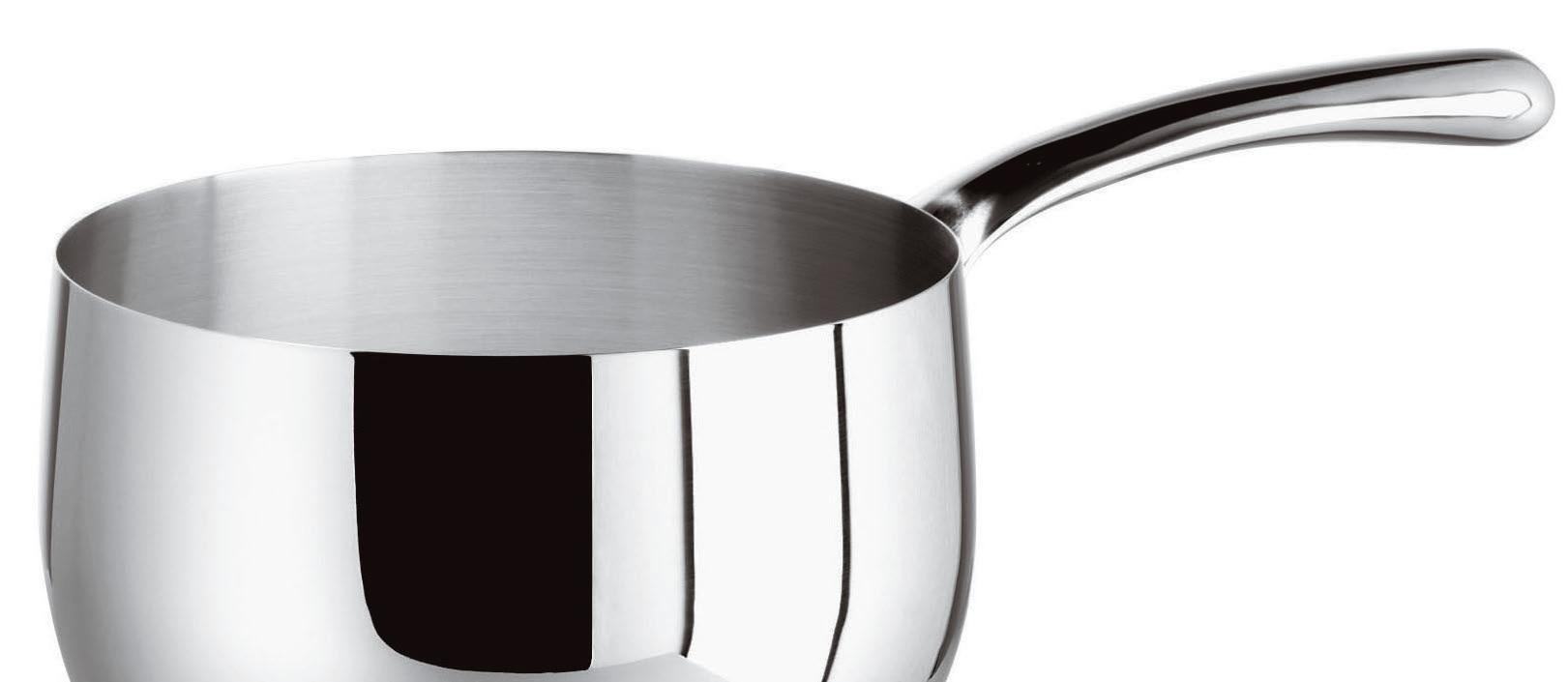
• Access to a corporate gym;
• Access to the company restaurant;
• Access to free drinking water in the Novara plant;
• Flexible working time through the offer of part-time contract types that meet the needs of some employees. During 2021, 9 employees had a part-time contract
Becoming one of the pioneers of the territory, since 2018 Sambonet Paderno Industrie has joined the European Network WHP, a network of organizations and individuals committed to developing and promoting good health practices in the workplace, which in turn contribute to sustainable economic and social development in Europe
In addition to providing preventive measures for accidents and illnesses in the workplace, the company is proactively working to offer employees with opportunities to improve their individual and family status, from conventions for the purchase of goods and services to facilities for work from home and reconciliation between professional and personal life.
All the initiatives promoted by Sambonet are aimed at achieving a balanced lifestyle with respect to nutrition, sports and emotional context and thus ensure the well-being of its employees.

To underline the strong interest of Sambonet towards "beauty", there are not only the countless collaborations with international artists, but also the furniture of the same venue.
Sambonet is committed to creating for its employees a working environment attentive to artistic detail, to create a comfortable atmosphere that positively affects the well-being and sense of belonging to the corporate culture of employees.
Therefore, the property has furnished the company with the aim of creating a welcoming and inspiring place for all employees and at the same time, promoting the Italian craftsmanship of which the company itself is a landmark. The Novara office boasts a collection of about 30 works of art, paintings and sculptures of interiors and exteriors, mainly made by Italian artists still alive.
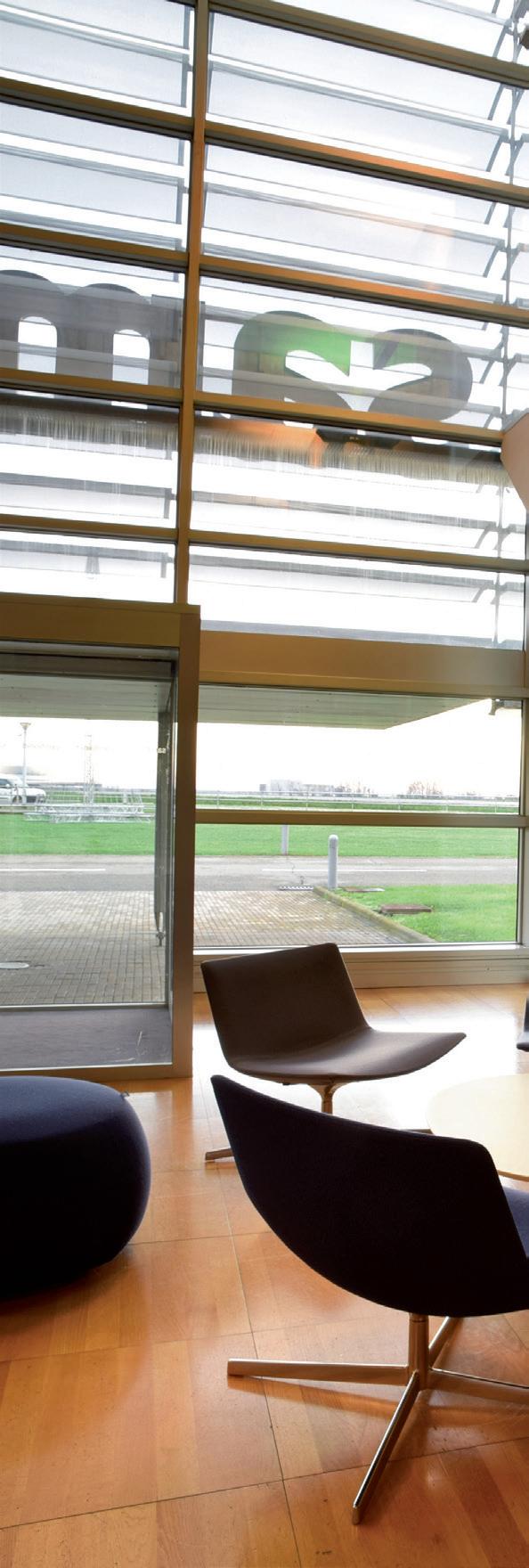



Sambonet adopts an integrated system of management and development of human resources that offers all its employees equal opportunities and professional development, based on merit criteria, avoiding any type of discrimination (gender, racial, sexual, etc.).
The Company not only leads personnel management (e.g, hiring, promotions, etc.) avoiding any form of discrimination, but is also committed to promoting an inclusive working environment by banning, within the Code of Ethics, any behavior of verbal, physical or psychological violence by an employee to any individual inside or outside the Company. In 2021, the Company’s commitment to these issues resulted in zero discriminations
In particular, with respect to the subject of remuneration, the Company is working to eliminate the gender pay gap (pay gap between male and female employees in the same role).
This is how Sambonet promotes an inclusive work environment: countering all forms of discrimination in company policies and practices and ensuring psycho-physical well-being and employees satisfaction.
Sambonet has demonstrated its commitment to the issue of gender pay gap also through its participation, during 2021, in the initiative "Women in food". The Creative Director of Sambonet, in the place of the entire Society, participated in the event, organized by Cook of “Corriere della Sera”, where chefs, food writers and entrepreneurs told how they transformed food into a driver for female empowerment. In particular, Sambonet was part of a panel discussion dedicated to the theme of the "Vision", to witness how corporate innovation has guided the recent international successes of Sambonet.

"Women in food THE WOMEN’S FOOD FORUM"
HEALTH AND SAFETY
Sambonet cares about the health and safety of its personnel and for this reason seeks to create safe and comfortable working environments, spreading the "culture of prevention" accompanied by concrete measures, formal procedures, monitoring systems, and periodic training.
As proof of the Company’s attention to ensuring safe working conditions, in 2021 there were 0 cases of injuries and occupational diseases related to the workplace. The Company believes that security, by its nature, is a "status" that implies the participation of all resources and is attainable through acknowledge of risks and their prevention and therefore it develops through:
• DISSEMINATION OF CULTURE OF PREVENTION.
• THE ONGOING RISK ASSESSMENT BY THOSE WHO WORK "IN THE FIELD".
• DETECTING THE TREND OF THE ELEMENTS OF DISTRESS.

• THE RISK ANALYSIS.
For safety management, the Company obtained, in 2020, the ISO 45001:2018 certification, for which the Company is periodically subjected to specific audits that ensure compliance over time with the requirements of the system.
The safety management system is based on following pillars:

• EMPLOYEES TRAINING AND INVOLVEMENT;
• ASSESSMENT AND RISK MANAGEMENT;
• MONITORING AND MANAGEMENT OF ACCIDENTS.
Sambonet focuses on the widespread awareness among workers of the risks related to work activities as a form of prevention. The Company, to root the sense of awareness in all the staff, promotes countless training and education courses in health and safety, provided by qualified personnel, sometimes internal, sometimes external:
• Compulsory training courses for the entire company population;
• First aid courses for competent personnel;
• RSPP and RLS refresher courses;
• Fire training;
• Specific courses on the use of certain machineries.

The active involvement of employees is an important element in the process of raising employees’ awareness toward health and safety risks. Indeed, Sambonet encourages all the workers to report any situation of danger occurred or that may occur (near miss).
For this reason, the Company has implemented the PS009 procedure on internal communication of near miss. This procedure outlines the ways in which it is possible for an employee to make a report:
• by special mail;
• using the boxes in the canteen and reception;
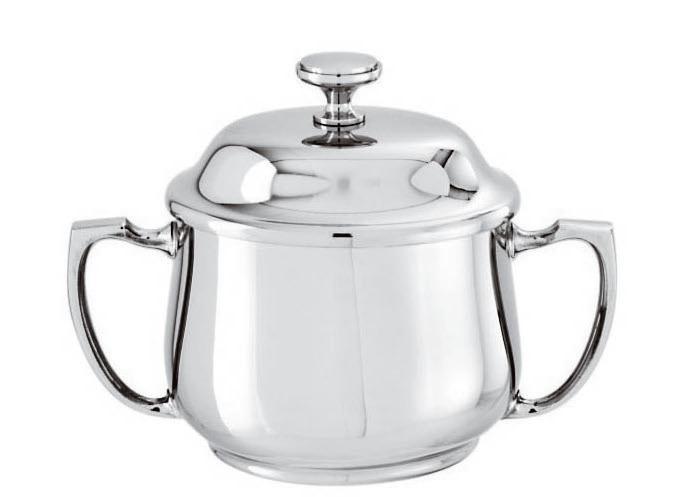

• through its supervisor, SGM, MSW and/or RSPP or ASPP.
After the report has been made, the security team in charge reviews the cases and the preventive actions to be taken.
Sambonet then prepared the Risk Assessment Document pursuant to Legislative Decree 81/06 and s.m.i., periodically revised and integrated according to the evolution of the business environment. The evaluation methodology was set up without neglecting any relevant aspects and giving order to the information collected, developing the following operational objectives:
• Identification of workplace dangers and assessment of the risks associated with them.
• Justification of the method and the technical choices adopted for the risk assessment in order to draw up a report, as motivated as possible, concerning machinery, equipment and products;
• Monitoring the adequacy of the measures taken;
• Establish a priority list if further measures are needed;
• To demonstrate that all factors relating to work have been taken into account and this has allowed a valid and reasoned assessment of the measures taken;
• Ensure that the measures taken, as a result of the risk assessment, are effectively improving the level of protection of workers.
The main categories of risk are related to the machinery used in the technical/production departments and industrial activities (e.g., noise, carcinogens and mutagens, asbestos, etc.).
Accident management is supported by written procedures, which comply not only with laws and regulations but also with ISO 45001. The procedures define the roles, responsibilities, actions to be taken to report accidents (both actual and near-miss) by employees and, finally, the activities to be implemented once the report is received: specific investigations with recognition of any noncompliance and corrective and preventive actions.
Proof of the attention that Sambonet pays to the protection of the workplace, during 2021 there were no accidents, and, therefore, the accident frequency index is 0, down compared to 2020 where it was 1.7 (as there were 3 accidents). This result is the culmination of a five-year trend that the good management of the issue has made it possible to achieve.
In view of the marked improvement that has therefore been recorded in health and safety management, the current Company’s priority is to keep the figure close to zero, continuing to provide education, information and training to maintain a good level of awareness of the risks and dangers associated with each task.
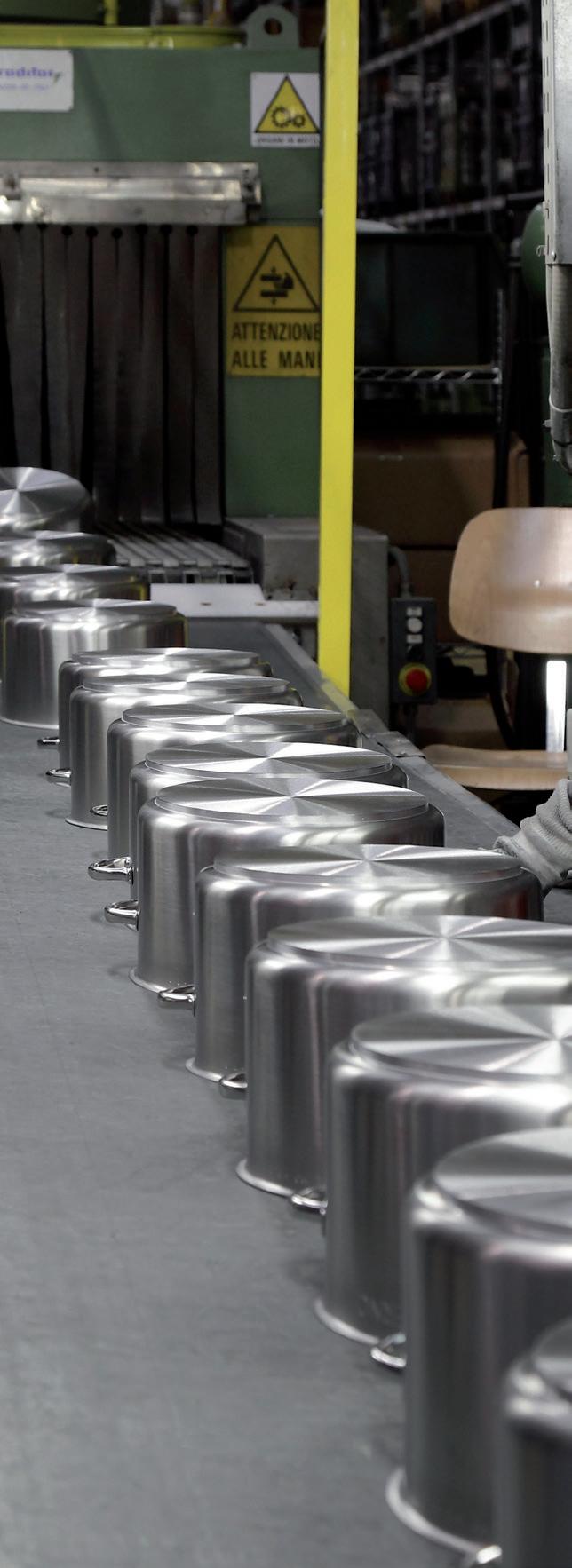
zero
Number of employee accidents in 2021
Sambonet Paderno Industrie responded in a timely manner to the health emergency from Covid-19. In the last two years, the Company has made the protection of employee a top priority and for this reason it has:
• established an Emergency Committee;
• formalized protocols aimed at ensuring the health and safety of employees that outline extraordinary responsibilities and provide for the implementation of all common anti-contagion rules such as the installation of separators and distributors of sanitizing gel, sanitization of all environments, etc.;
• activated smart-working within two weeks from the start of the pandemic. Although the remote working mode is no longer mandatory, Sambonet still gives its employees the opportunity to work from home through agreements.
Moreover, in March 2020 the plant was closed for a month. In this circumstance the Company had to adopt the instrument of the Integration Fund anticipating salaries. To further help the families of its employees, even corporate the premium that is usually paid in June, was liquidated in April.

Sambonet, to preserve the notoriety and success due to the quality and design of the products offered, pays extreme attention during each phase of its value chain: from the conscientious supply of raw materials to be used to the production process oriented towards continuous innovation and the optimization of waste and consumption.

The high quality and reliability of the products that distinguish Sambonet are guaranteed, among other things, by the management of the production chain that contributes to the realization of the finished product.
The Company establishes strong, lasting relationships based on mutual trust with its suppliers.
To ensure the excellence that has always characterized its products, Sambonet meticulously selects the entities with whom to collaborate, following strict criteria both in the ethical and environmental field
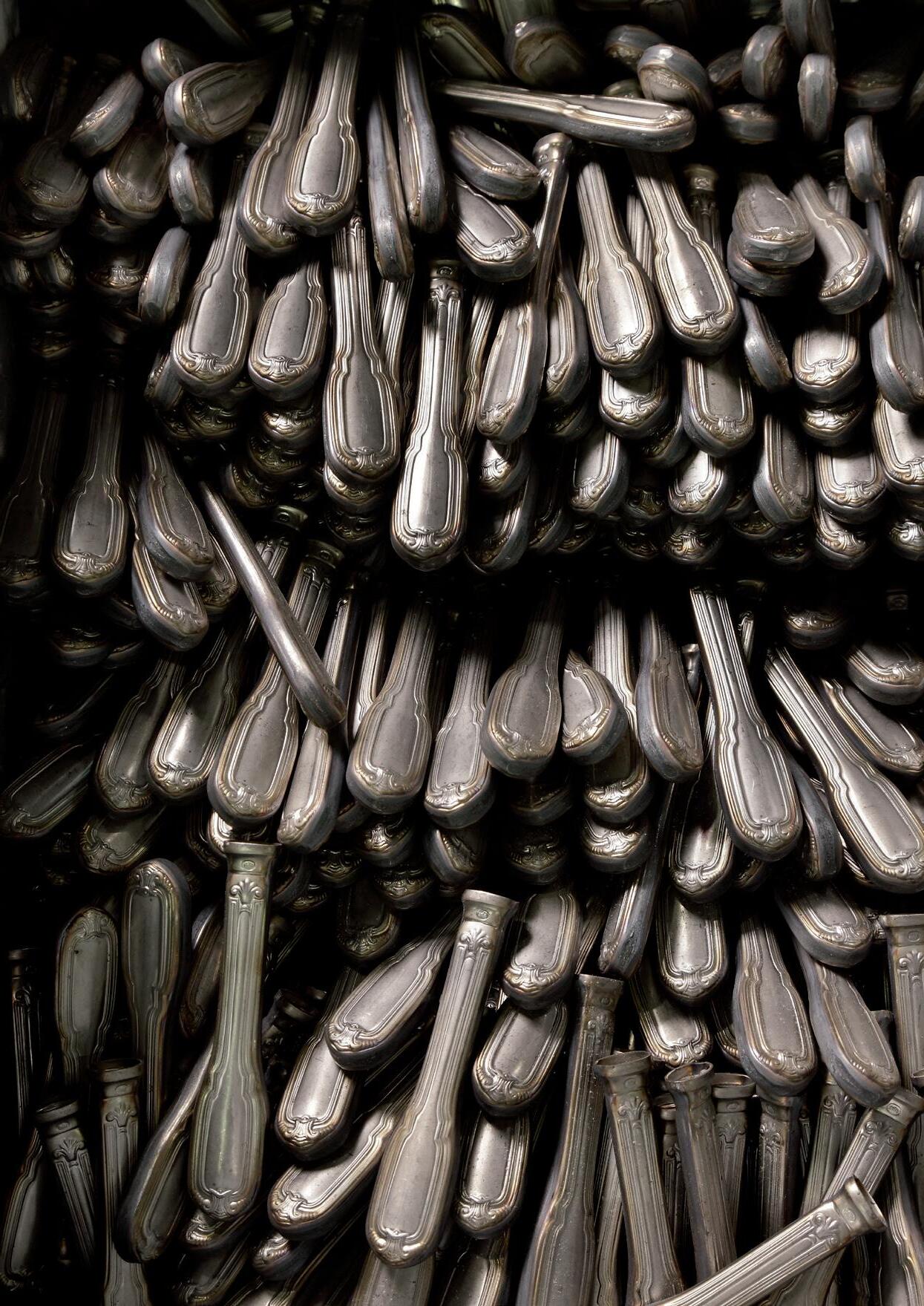
Almost all the raw materials used by the Company are metals (in particular stainless steel, aluminium, nickel silver and brass). The totality of the suppliers is constituted from resellers, of which 76% placed in Italy, while the remaining part coming mainly from Germany, France, Hungary, Turkey, India and U.S.A. To these last ones, Sambonet asks the declaration of absence of "Conflict Minerals1" both in the qualification phase and in the subsequent period, annually, as a guarantee of the responsibility of the entire downstream supply chain of its supply chain.

one thousand
companies
27,970,714 euros
1 Conflict Minerals are natural resources mined in conflict zones and sold to perpetuate hostilities. Various armies, rebel groups and external parties profit from mining, while contributing to violence and exploitation during wars in these regions.
2 In this context, "total annual expenditure" means how much Sambonet has spent in the course of 2021 towards the totality of the suppliers. The total of suppliers includes the following categories: retailers of raw materials, contractors, suppliers of semi-finished products, consumables, goods and services, packaging and packaging materials. For further details on the expenditure towards suppliers incurred by Sambonet in 2021, refer to the GRI 204-1 performance indicator Proportion of expenditure to local suppliers -Table No. 19.
The company buys semi-finished products and components that, subsequently, through techniques and maximum experience, are reworked or, in the case of components, assembled to the body of the product

Sambonet relies on third parties for processes that require specific technical skills, such as surfaces finishing treatments or heat treatments. The Company, committed to enhancing its territory, collaborates with local contractors, located in the province of Verbano Cusio Ossola or in the Po Valley. This brings out an attention from the company to favor, where possible and preferable, relationships with suppliers located near the plant and the operating area, for better organizational capacity, to avoid emissions due to unnecessary movements and to contribute to the economic support of the territory
Then is important the increase in spending (47.9%) towards local suppliers3 (compared to the previous year) that has certainly had a positive impact on Italian companies, especially considering the period of difficulty still marked by the effects of the pandemic from Covid19.
For Sambonet Paderno, the awareness of the entire supply chain on ESG issues is a priority. The company, with its integrated management system for quality, environment, energy, social responsibility and safety wishes that its employees also feel strongly about these issues. To empower the entire supply chain, the Company has introduced the so-called "Qualified Suppliers List", a list drawn up on the basis of the responses to an assessment questionnaire to which suppliers are subjected
3 The meaning "local" is used in this context for suppliers whose company name is Italian.of annual expenditure is
towards local suppliers

Sambonet, as a socially engaged organization, feels the responsibility to develop a business model that allows it to transmit its values through the production chains: for this reason, since 2011 it has implemented the Code of Conduct for manufacturers and suppliers.
The Code includes principles and standards for the correct development of relations between the Group and its suppliers and has been formulated through three fundamental criteria:
• ALL OPERATIONS MANAGED BY THE GROUP AND ITS EMPLOYEES MUST BE DEVELOPED FROM AN ETHICAL AND RESPONSIBLE PERSPECTIVE
• ALL PEOPLE WHO HAVE, DIRECTLY OR INDIRECTLY, ANY KIND OF EMPLOYMENT, ECONOMIC, SOCIAL OR INDUSTRIAL RELATIONSHIP WITH THE GROUP MUST BE TREATED IN A FAIR AND HONOURABLE
• THE DEVELOPMENT OF THE GROUP’S ACTIVITIES MUST BE CARRIED OUT IN THE MOST ENVIRONMENTALLY FRIENDLY MANNER
The aim of this document is to raise awareness of these interlocutors on purely ethical, social and environmental issues, so as to ensure, apart from quality, reliability and safety of products processed and distributed on the markets, the protection of the environment and health, compliance with ISO standards, a remuneration that guarantees a dignified lifestyle, and finally, fairness in business activities.
Once arrived, the raw material is stored in the warehouse and, subsequently, prepared for use in production processes. The process to produce an article is composed of multiple phases whose nature and sequence varies significantly according to the final product (pots vs cutlery vs tableware...). Once finished with the final cleaning, an object can be subjected to further processes such as silvering and the galvanic gilding or PVD, before being assembled/packaged.
CUTLERY
• Roughly shaped slice
• Lamination
• Blanking of profiles
• Punching
• Washing
• Stamping
• Polishing
• Final washing
ARRIVAL RAW MATERIAL
STORAGE RAW MATERIAL PREPARATION MATERIAL
POTTERY
• Drawing
• Shearing/Trimming
• Inflation
• Washing
• Cleaning
• Final washing
Silvering / Gilding
PVD
Mounting / Assembly
Testing / Packaging
Storage of Finished Products
Shipment
COOKWARE
• Drawing
• Shearing/Trimming
• Washing
• Brazing
• Turning
• Cleaning
• Final washing
The sustainability of the production process of Sambonet is dictated by the use of cutting-edge machinery, which respond to the highest levels of technological innovation and the quality of materials used within the process.
Over the years, Sambonet has invested in increasingly innovative and more efficient processes and machinery, ensuring better environmental performance. At the same time, the company uses, as its main raw materials, materials with a reduced presence of dangerous substances, such as steel, alpaca and aluminium and with intrinsic durability and stability, in addition to being recyclable materials
One of the distinctive choices of Sambonet’s commitment to reducing environmental impact, was to replace the traditional acetylene welding with a hydrogen welding. Using a generator that carries out
a process of electrolysis of the water, it creates a flow of oxygen, released into the atmosphere, and hydrogen, which is fed to the welding stations to the torch. The gas ignites in a blue flame that is used for welding and, in contact with the oxygen in the air, is transformed again into water vapor, thus achieving a process with zero CO2 emission.
Another example of attention to waste and environmental impact, is given by the company’s washing plants, built with a system of recovery and recycling of water to avoid water waste.
In addition, Sambonet realizes all its vibrofinishing processes, made to obtain the vintage finish of its products, using abrasives derived from recycled recovery materials (PET).
The company has also introduced water cutting, which allows the processing of a wide range of materials through a high-pressure water jet mixed with an abrasive powder. This technique combines high production efficiency with maximum levels of precision and consequent cost optimization. In fact, the Waterjet machinery guarantees optimal use of the raw material and does not need subsequent finishes.

4 For more information on the nature of materials (renewable/ non-renewable) see Table 20 on GRI 301-1 "Total consumption of raw materials".




Sambonet has always been committed to reducing environmental impacts and promoting process efficiency: the entire plant is designed for the optimization of water and energy consumption and over the years the investments on the plant have allowed to optimize waste management too and mitigate emissions into the atmosphere.
The Company is also committed to the research of environmentally friendly materials or with low environmental impact to be used in production processes such as the materials with vegetable origin used for the drying of the pieces produced by the galvanic/recovery plant as for the vibrofinishing plant
Among the various initiatives pursued, Sambonet is working, with the support of the internal Aseclab Laboratory, on a project whose aim is to adopt new washing solutions that improve the efficiency of the process and the quality of the result, with particular attention to the reduction of energy consumption and of dangerous and/or harmful substances for the environment.
In addition, in 2020 the management of the printer fleet was changed, removing, where possible, the machines from the offices and creating work islands to cover the various business areas with a reduction in the number of printers of about 30%. The reduction in the number of copies is monitored using collection badges
In this perspective, the Company strives to implement a planned long-term strategy with investments and projects, which have in common the objective of systematically reducing the Company’s ecological footprint

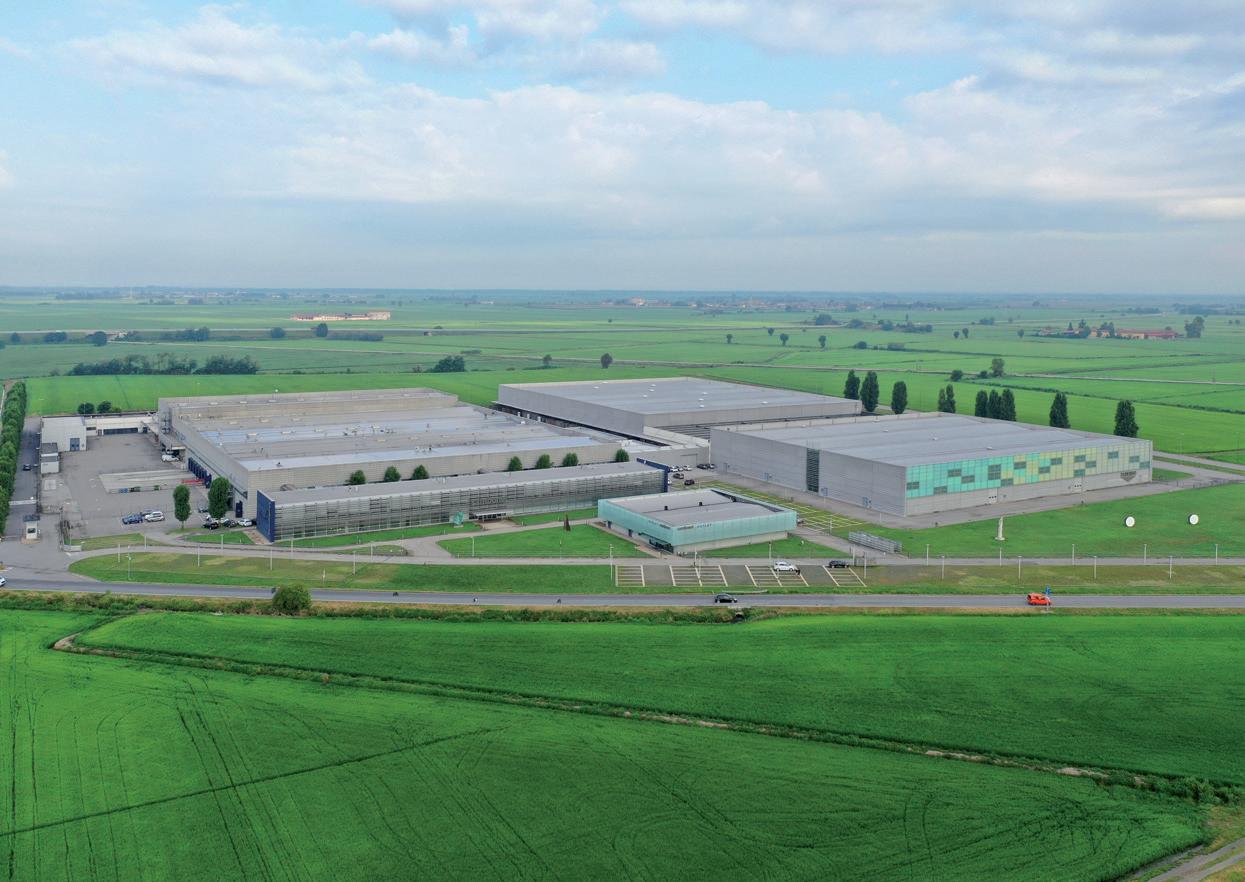
Sambonet is aware of the fundamental importance that careful energy management has both internally and for the community and the environment.
For several years, in fact, having an integrated policy that responds to ISO certified management systems, it annually implements monitoring activities such as:
• Energy analysis carried out by the Green Team;
• Energy Diagnosis carried out by third parties;
• Punctual systems for monitoring energy consumption through meters also installed on the various production lines;
• Calculation of specific KPIs in the field of energy performance.
The set of these monitoring actions allows the Company to identify the most significant areas of energy consumption, possible inefficiencies or problems, which cause for example losses and general malfunctions, and opportunities to improve performance in order to define objectives, targets and action plans
In the field of environmental and energy management, Sambonet has, since 2015, certified management systems respectively ISO 14001:2015 and ISO 50001:2018 The integrated management system, through formalized policies and procedures, ensures that Sambonet has a solid and constant control over environmental issues
Sambonet uses natural gas for heating the plant and the warehouse on the one hand, and for the operation of washing machines located in the various production departments on the other, in this case, in fact, methane is necessary for heating the solutions to 50 and 60 degrees and for drying the pieces, as well as to feed the furnace for welding some products.
The Company uses electricity mainly to power its production processes and to supply energy offices. The Company believes in renewable energy and has shown this in the choice of electricity suppliers. Since 2014 Sambonet uses electricity 100% covered by certificates of Guarantees of Origin

The company uses Diesel fuel exclusively for the movement of a limited fleet of vehicles. Instead, it doesn’t have heavy vehicles because the logistics is entrusted to a network of couriers
IN PARTICULAR, THE FLEET OF SAMBONETS IS STRUCTURED IN THIS WAY:
10 vehicles for business use
10 vehicles assigned to employees
3 trucks
27,029 GJ (7,508 MWh)
energy consumption, for production activities, equal to with an increase of 27% compared to the previous year
In 2021 Sambonet recorded, overall, in which consumption was 21,134 GJ (5,870 MWh).
Electric Energy
4,116 MWh
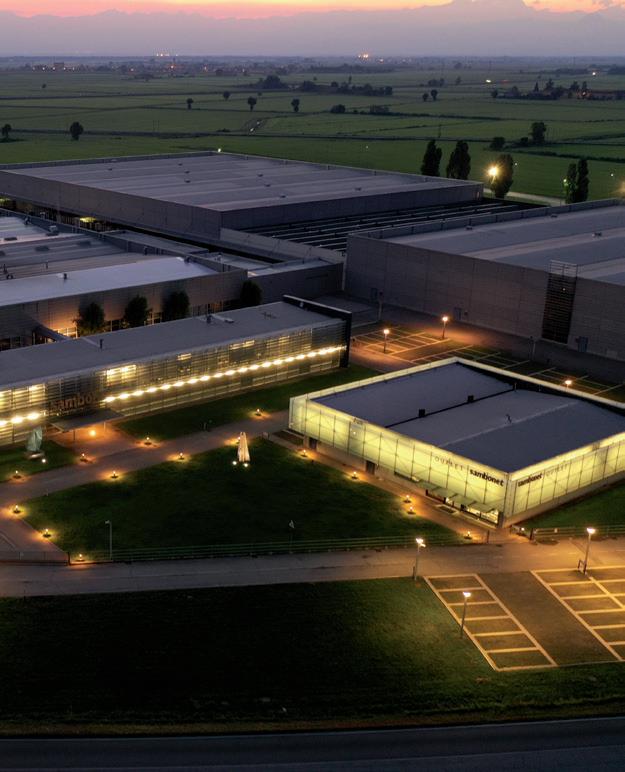
14,818 GJ
Natural Gas
285,783 Sm3
11,350 GJ
Diesel
The growth in consumption is largely due to the reduction in production in 2020, in which production processes were stopped for a month with the aim of reducing the infections of Covid-19
More specifically, the main consumption is due to the use of electricity, equal to 14,818 GJ (4,116 MWh) in 2021, while the consumption of Natural Gas recorded, again in 2021, 285,783 Sm3
In addition to the above consumption, and referring to production activities, should be considered the consumption of the car fleet whose consumption was recorded for Diesel 23.972 l in 2021 (24.908 l in 2020).
Energy intensity (Gas Methane)
To improve and make the Company more efficient from an energy point of view, Sambonet has invested in energy efficiency activities over the years through, for example:
• Intelligent lighting systems that provide sensors for automatic adjustment compared to the natural light in the environment;
• Energy saving measure such as the prohibition to turn on the lights in the "daytime" area from 23:00 until 6:00;
• Replacement of machinery or parts of the same that led to waste or poor efficiency;




• Energy consumption monitoring system thanks to the installation of meters on all production lines in a uniform manner, to ensure completeness in monitoring.
With the aim of continuing to improve, the Energy Team started in the first quarter of 2021 the selection of projects for the construction of a photovoltaic system, to be placed on the company roofs, dedicated to the coverage of about 35-40% of the company’s electricity needs
One of the additional goals on which Sambonet works is to improve environmental culture with systematic education, information and training, in order to increase the level of awareness of hazards and risks, and knowledge of techniques for the prevention of environmental problems, correct application of laws and regulations.
0.06
0.07
Energy intensity (Electric Energy)
0.88 1.35
The energy intensity indicators were calculated as the ratio between energy resource and pieces produced during the year 2021 (4,657,199 pcs) and 2020 (2,394,294 pcs).
The indicators show that between 2020 and 2021 there was a decrease in energy intensity per piece, showing how the energy efficiency actions implemented by the company are important. In particular, these indicators show the good job of industrialization Sambonet has done managing to optimize the cycle of use of the machines with a reprogramming of processes and an increase in employee turnover.
Sambonet Paderno Industrie has chosen technological solutions that optimize the quality and quantity of emissions into the atmosphere; the emissions are low air pollution and are authorized in compliance with the emission limits and requirements indicated, for the type of processing carried out, in the D.D. of the Piedmont Region n. 145 of 2 May 2011 and in accordance with the current national legislation on environmental protection (Legislative Decree 152/06, Environmental Code).
For Sambonet, the commitment to this important issue translates not only into the monitoring of direct and indirect emissions of GHG, but also in the monitoring of further significant emissions that some production plants produce mainly in the departments of:
• mechanical production;
• galvanic.
In this regard, the Sambonet plant is in possession of a Single Environmental Authorization (SEA) relating to emissions into the atmosphere and water discharges, last updated in 2021 following significant changes in installations and consequently in the composition of emissions associated with them.
The polluting emissions regulated within the SEA, and subjected to periodic monitoring as required by law, are:
• Powders and oily mists produced by plants such as turning, rolling, brazing, and welding;
• Total dust and other pollutants emitted during the galvanic phase, such as nitrogen oxides (NOx) and other substances;
For Sambonet, self-control analysis is not a mere fulfillment prescribed by the Single Environmental Authorization (SEA), but a useful process of periodic monitoring of the environmental impact of the production process, from a risk/opportunity analysis perspective for the continuous improvement of environmental performance
Direct GHG emissions
598 tCO2
Indirect GHG emissions
Scope 2 (market based)
Scope 1 0
Indirect GHG emissions
Scope 2 (location based)
1,069 tCO2
2021 Direct emissions (scope 1) corresponds to the amount of CO2 stored from about 3,850 trees in a year5
5 The amount of CO2 stored by a tree is very variable and depends on the species, size and many other parameters. In this case reference was made to a turkey oak tree, considered excellent as CO2 storage, equal to 155 kg/year (ref. Calculation of the carbon footprint for the reduction of emissions by planting - Polytec Technology Srl).
Water is of crucial importance for the planet and its ecosystems, as well as for humans. At the same time, water is at the heart of Sambonet Paderno’s production processes. Sambonet is aware of the value of water and is committed to using it in the most rational and ecological way possible.
The water withdrawal takes place mainly through two wells owned by Sambonet, authorized for industrial use for water supply and whose total capacity is 46 liters/second, and for a residual part, through the aqueduct of the Municipality of Casalino. Sambonet can also boast a purification system, which allows, in part, the recirculation of water, thus contributing to the overall reduction of water withdrawal.
The company uses the water resource for civil uses, but especially for industrial uses during some specific stages of the production process. In particular:

• For silver plating treatments;
• During the extraction and pickling phases, where the pieces of pottery and cookware are treated in water with nitric and sulphuric acid;
• During the moulding of the pottery through water-jet plants that allow the product to take on rounded shapes;
• In the final washing phases where the products through treatment tanks and washing tunnels are cleaned for several years with aqueous solutions of detergents, and no longer with chemical solvents, to minimize water pollution.
WATER WITHDRAWAL AND DISCHARGE
113 thousand m3
of water withdrawn in 2021 (94 in 2020) of water discharged in 2021 (66 in 2020)
83 thousand m3
After the chemical-physical treatment of industrial water, and clarification of domestic water, the wastewater is sent to the Busca irrigation channel The discharge activity is conducted by Sambonet in accordance with the Legislative Decree 152/06 as well as the provisions contained within the SEA that authorizes Sambonet to discharge into surface water. The chemical-physical treatments performed by a purifier owned by Sambonet, allow to purify the water through operations such as oxidation of cyanides, reduction of organic substances and metals, sand filtration to ensure the quality and compliance with all the parameters required by the above-mentioned provisions.
The company carries out a constant monitoring activity, not only on the quantity of withdrawals and discharges, through meters installed in 2019, but also and above all on the quality of the discharges The Company carries out daily analysis activities on discharges, through which the values of nickel and total cyanides are analyzed; these activities are carried out by the internal laboratory of Sambonet, AsecLAb, which in 2013 was accredited as an analysis laboratory pursuant to UNI EN ISO 17025
Overall, in 2021, there was an increase in the levy and consequently in the discharge compared to 2020. Even in this case the change is mainly due to the reduction in production recorded in 2020 due to the restrictions imposed for the management of the pandemic by Covid-19
Inside the Sambonet Paderno plant, there are five washing machines located in different departments. The operation of these systems fully corresponds to the Company’s philosophy of using water as a resource not to be squandered, with the aim of achieving the lowest possible consumption.
For this reason, the washing tunnels provide rinsing ramps with adjustable and measurable flow through flow meters; the power supply of each ramp is controlled by a level switch placed in the tank of that washing section and if necessary, a water flow from the next section comes into operation. In this way, the solutions of the cleaner rinsing tanks feed the previous rinses thus providing a mechanism of "re-use"
Managing waste responsibly is one of the main prerogatives of Sambonet. The commitment of the Company is a constant and continuous improvement of waste management and technologies used during production, optimizing the use of raw materials and minimizing waste.
In addition to preventive initiatives to reduce waste, in the production site is strongly promoted waste recycling of paper and cardboard, plastic, aluminium, nickel silver, steel, wood, copper, iron, toner, neon tubes, trying to constantly motivate the collaborators
WASTE FOR DISPOSAL (t) 2021
1.7
9.2 15.5
3.7
In 2021, civil and industrial activities led to the production of a total of 476 tonnes of waste, of which 80% was non-hazardous (they do not have any of the hazardous characteristics pursuant to Annex III of Directive 91/689/EEC).
The composition of the waste is mainly of materials derived from production processes such as metals, cardboard packaging and, to a lesser extent, sludge produced by washing. All waste (both those destined for landfill and those destined for recovery) is managed externally through local companies specialized on waste treatment. Most of the waste (about 67% in the year 2021) is destined for recovery. Paper, cardboard and metals are completely managed through recovery.
WASTE FOR
0.1
(t) 2021
Packages
2.7
Electronic materials
81.7
27.7
water
17.5
210.9 Metals
95.3 Paper and cardboard Other
7.6


The dynamic balance between tradition, craftsmanship and innovation is the basis of the Company’s work. The idea of modernity of Sambonet Paderno in the table and kitchen is born from the awareness of its history and its excellence, to be preserved, but also to be reinterpreted in the light of contemporary trends and customer needs.

Create integrated solutions OF QUALITY, DESIGN AND FUNCTIONALITY.
ANTICIPATE AND SATISFY THE NEEDS OF OUR CUSTOMERS, in their professional life or in their families, through a portfolio of distinctive but complementary products.
Pursue an ETHICAL AND SUSTAINABLE PATH OF CONTINUOUS INNOVATION that is born from our tradition, interprets contemporary trends and creates new ones.
Sambonet Paderno is the promoter of these principles and acts daily so that they are pursued and valued in the culture of the Company.

The table products and furnishings made by Sambonet Paderno are recognized and appreciated for the high quality that distinguishes them. The maintenance of the high-quality standards that characterize this reality is based on a great commitment on the part of the Company that translates into careful attention during all stages of product processing, formalized policies, efficient quality monitoring systems and maximum attention to the customer and his needs.
In the field of quality management, thanks to the certified management system ISO 9001:2015, since 2005 Sambonet Paderno Industrie offers the guarantee of a production of high-quality products, fully compliant with the regulations, as well as customer requests and expectations. The company is subjected annually to audit activities that certify the maintenance and adaptation of its production process to the requirements of UNI EN ISO 9001:2015.

The certified Quality Management System allows the company to act in compliance with the strictest quality criteria of production. In 2021 there were 0 non-compliances, both from the environmental and the system point of view. Product control, which takes place at the Orfengo production site, is applied in all processes and business activities that affect the quality of products and customer satisfaction. The control activities are carried out by Quality Control and Production staff, as well as by Contractors, when required
It clearly and programmatically defines the steps to be followed so that the production of the plant complies with internal and external regulations and is in line with the agreements made with the customer.
A Quality Control Plan is prepared for each process, in which every check to be carried out, its frequency, the measuring instruments to be used and the established acceptance criteria are defined. In addition, to ensure the compliance of its products, the company has set up a system of monitoring, measurement, analysis and improvement of processes and the Quality Management System.
The quality and safety of Sambonet Paderno products cannot be separated from compliance with the applicable legislative and regulatory requirements for food safety. In this context, in fact, the company has implemented over the years an efficient Food Safety Management System (FSMS) for all items that come into contact with food.
In general, every product of Sambonet Paderno Industrie is safe for food contact thanks to the compliance with the quality requirements traced along the entire supply chain: from the application of HACCP to health and hygiene regulations established by international standards.
Since 2004, the products of Sambonet Paderno also boast the NSF certification (National Sanitation Foundation) for food safety, ensuring that the product come into contact with food without any risk to health.
In the field of food safety, since 2013 Sambonet can boast an SMSF certified by an external body EN ISO 22000:2018 Periodically the Management System is subject to internal checks and external audits that certify the maintenance and adaptation of its production process to the requirements of the standard.

Sambonet Paderno Industrie has always invested in qualified personnel, technology and equipment, creating an internal laboratory to carry out direct analysis on materials and objects that come into contact with food.
Since 2013, thanks to the Accredia certified laboratory, ASEC Lab -AlimentarySecurity Control, the company can guarantee the suitability and safety of each item placed on the market, whether it is produced directly or distributed. In addition, it is autonomous for issuing declarations of conformity on steel, aluminium, porcelain, glass, plastic materials and dyes, internationally recognized.
PRODUCT SAFETY
• GUARANTEES THE SUITABILITY OF EACH PRODUCT FOR FOOD CONTACT THROUGH MIGRATION TESTS CARRIED OUT IN ACCORDANCE WITH CURRENT REGULATIONS;
• ACCREDITED TESTS FOR THE DETERMINATION OF OVERALL MIGRATION/SPECIFICATION ON CERAMIC, STEEL, PLASTIC, GLASS AND METAL ARTICLES;
• NEW IMPLEMENTATIONS SUCH AS, FOR EXAMPLE, SENSORY TESTING.
ENVIRONMENTAL MONITORING
• WATER DISCHARGE MONITORING AS REQUIRED BY SEA;
• ACCREDITED TESTS FOR THE DETERMINATION OF METALS;
• PH AND SOLVENTS ON WASTE WATER AND GROUNDWATER.
PRODUCTION PROCESSES
• THE LABORATORY SUPPORTS PRODUCTION PROCESSES THROUGH SPECIFIC CONTROLS.
11 ACCREDITED TESTS MORE THAN 1,000 ANALYSES PER YEAR

4.1
AT THE CENTRE OF OUR ATTENTION THE PRODUCT
Sambonet products are unique thanks to the expertise of the artisans who, in addition to ensuring the accuracy and uniqueness of each creation, using innovative techniques guarantee very high precision at every stage of the manufacturing process
Innovation, which is a transversal concept within the company, is promoted both by the Technical Office and by the various business units. The innovative drive and the consequent optimization of the company’s products and production processes are generated by several factors, including market demands, the desire to diversify from other companies in the sector and the strong consideration of preferences in the field of sustainability and innovation of customers.
As proof of the importance that the company has for the theme of innovation and product sustainability, Sambonet dedicates a large part of its annual expenditure to Research and Development
Only in 2021, the expenditure related to Industry 4.0 was almost 2.5 million euros; this considerable investment aims to ensure the use of production techniques at the forefront, ensuring the optimal performance of machinery, in terms of precision, effectiveness and efficiency, and creating ecosustainable industrial processes
The know-how capital of which Sambonet is in possession today, has distant origins that reside in the founders of the two souls of the company. However, the Company has continued to invest over the years, using state-of-the-art processes and technologies, the use of which has increased the accuracy of metalworking, reduced waste and increased energy efficiency, helping to reduce environmental impact.
Over the years, the company has registered several know-hows related to production processes.
Among these Sambonet can boast some processes of galvanic silvering as well as the PVD coating process and the special vintage, antique and diamond finishes, which in addition to being an expression of the highest quality, add to the cutlery a texture of design and exclusivity for customers.
The PVD coating consists of a highly innovative treatment that gives the objects precious colors and trendy shades. It is used for the deposition of thin films on the surfaces of objects to be covered (for example, knives, other cutlery or pottery).

PVD coatings are distinguished from common surface finishing methods since they guarantee a higher quality, non-toxic and high resistance to the aggressive action of external agents.
The innovative and sustainable aspect of this technique also lies in encouraging the reduction of the use of chemical substances such as cyanides and acid solutions, which are more used in galvanic processes. The PVD finish also allows a better environmental performance

Ensuring full customer satisfaction is for Sambonet Paderno an absolute and essential priority, together with the drive towards innovation and sustainability. For this reason, it is committed daily to offer its consumers quality products and to ensure compliance with the methods and delivery times.
For Sambonet it is essential to establish a consolidated and lasting relationship of trust with customers. For a continuous strengthening of the same, the company has implemented over time instruments and channels of measurement of customer satisfaction. Thanks to the Quality Management System, formalized and certified for about 10 years, Sambonet annually measures some KPIs expression of quality and customer satisfaction; the data that are collected are later
analyzed, to assess the effectiveness of the system but above all to identify the areas on which to implement improvement actions and set increasingly ambitious and challenging goals
The data are being analyzed on annual basis and relate, for example, to information about customer return (satisfaction, returns/complaints, etc.), product monitoring and process monitoring.
1.46% 0.32%
* The performance, which refers to the year 2021, is in line with previous years, however these data are not comparable with the indicators of 2020, due to the worsening of the COVID 19 pandemic situation. The commitment of Sambonet Paderno followed in 2021 was in fact to return to the usual performance levels, which make Sambonet Paderno a synonym of high quality and reliability.
A further fundamental tool for monitoring customer and consumer satisfaction are questionnaires given to customers to know them better and receive feedback on their opinion and experience. In the two-year period 2020-2021, it emerged that for the main customers of Sambonet - Resellers
and Retailers - the quality and service offer are excellent and that for the final consumer sustainability is a relevant issue. Therefore, Sambonet’s consolidated commitment to sustainable issues is also supported by the interest shown by its consumers.
Sambonet’s interest in knowing the expectations and the logic behind the buying behavior of its consumers has also been demonstrated through a market survey carried out in 2020 thanks to a renowned research and market analysis entity.
Within the context of the research, which involved almost 2000 people, it was possible to outline a map of needs based on the aptitude profiles of Sambonet consumers
The results of this analysis allow the Company to better address its strategic decisions on products, to ensure they are increasingly in line with customer expectations.

Sambonet Paderno is present in 90 countries, mainly in Italy, Germany and the United States. For this reason, the company considers it a priority to establish connections with customers also through participation in the most important Italian and international fairs in the sector. Each event is an opportunity to build an environment in which the novelties and the exhibition suggestions are the protagonists, generating an exchange of ideas and a collaboration with shared goals.


Sambonet Paderno annually organizes Roadshows - events smaller than fairsorganized in suggestive locations. In this way, the company can show its products closely to retailers, reaching them on the territory with intimate and engaging events, presenting the news and exhibition proposals. The impact of this initiative is certainly positive because the events have always been followed by significant commercial orders and an increase in customer loyalty.


This document represents the first Sustainability Report of Sambonet Paderno Industrie (hereinafter "The Company", or "The Firm"), drawn up in accordance with the "GRI Sustainability Reporting Standards" (2021) published by the Global Reporting Initiative (GRI), according to the "In accordance" option.
The Company, always committed to sustainability, publishes a Report that talks about its performance in this field for 10 years, but, for 2021, has decided to crown the consolidated commitment over time through a Report that outlines the main results in the economic, social and environmental field achieved during 2021, meeting one of the most widely used international standards of the moment. The document was drawn up voluntarily and responds to the Company’s desire to achieve an increasingly high level of transparency towards its stakeholders regarding their sustainability performance.
As already mentioned, the information and data reported refer to the year 2021 (from 1 January 2021 to 31 December 2021). In order to allow the comparability of the data over time and to evaluate the development of the Company’s activities, a comparison with the previous year has been proposed where available.
It is important to remember that following the demands of the GRI indicators for the first year, it is possible that different calculation methodologies have been used for some data already reported in previous sustainability reports, and that
consequently, changes can be observed compared to the same data for the years before 2021.
The indicators subject to reporting and the contents related to them were established on the basis of the results of the materiality analysis carried out in April 2022, which, involving the Management in an evaluation exercise through Survey on the relevance of significant environmental, economic and social aspects for the industry, allowed to identify the material issues for Sambonet Paderno and Stakeholder on which the document focuses. For further information, in the appendix to the Report you can consult the GRI Content Index where the GRI indicators associated with each material theme with corresponding nomenclature are listed.
The Sustainability Report was drawn up using the reporting approach described by GRI Universal 3 (2021) for the identification of material issues, which provides an understanding of the Company’s reference context, the identification of potential and actual impacts and their examination.
In fact, the information related to the identified material issues and the mapped Stakeholders, allow to report transparently the impacts of the Company in the context of its sustainability path. The document, finally, reflects the principles of GRI Standard 1 (2021) of accuracy, balance, clarity, comparability, completeness, context of sustainability, timeliness and verifiability.
The perimeter of the data reported in this document coincides with that of the Financial Statements of the Company.
The frequency of publication of the Sustainability Report will be annual. Furthermore, to ensure the reliability of the data, the use of estimates which, if available, are based on the best available and appropriately reported methodologies has been limited as much as possible.

The 2021 Sustainability Report was not verified by an independent third party, however it was submitted for approval by the Sole Administrator of Sambonet Paderno on 29/09/2022.
This document has also been made public on the Company’s website, available at the following address: https://www.sambonet.com/it-it/ sustainability.html.
For any information regarding the Sustainability Report, you can contact the following e-mail address: info@sambonet.it
CHAPTER 1
SAMBONET, FROM A MECHANICAL FIRM TO A LEADER GROUP AT AN INTERNATIONAL LEVEL
Economic performance
GRI 201-1
Table 1
GRI 201-1: Economic value directly generated and distributed by the Company
GRI
Table
GRI
Table
GRI
GRI 2-8 WORKERS WHO ARE NOT EMPLOYEES
Table 5
GRI 2-8: Total number of non-employees whose work is controlled by the Group, by type of contract and gender (headcount)
Table 6
GRI 401-1: Incoming employees by age, gender and geographical are
Table 7
GRI 401-1: Outgoing employees by age group, gender and geographical area
Table 8
GRI 404-1: Hours of training per capita by gender and professional category
Table 9
GRI 405-1: Employees by professional category and gender in percentage
Table 10
GRI 405-1: Employees by professional category and age as a percentage
Sambonet Paderno by gender and age as a percentage
GRI 403-8 WORKERS COVERED BY AN OCCUPATIONAL HEALTH AND SAFETY MANAGEMENT SYSTEM
5 The accident index is calculated through the ratio between the number of accidents and the hours worked by employees/external workers, multiplied by 2000 (Source: Sustainability Reporting Guidelines - GRI Standards version, Global Reporting Initiative). Recordable accidents at work are accidents requiring more than three days' absence from work, while accidents with serious consequences are accidents involving more than six months' absence from work.
6 The calculation of hours worked for the employees is made by taking as reference the hours resulting from the paycheck.
7 The calculation of hours worked for outside workers (interns) was made by estimation, multiplying the total number of days worked by 8 working hours per day.
GRI 302-1 ENERGY CONSUMPTION WITHIN THE ORGANISATION
Table 18
GRI 302-1: Total energy consumption within the organization by energy source, in GJ
GRI 302-3 ENERGY INTENSITY
Table 19
GRI 302-3: Energy intensity indicators by type of energy8
GRI 305-1 DIRECT (SCOPE 1) GHG EMISSIONS
Table 20
GRI 305-1: Direct greenhouse gas (GHG) emissions (Scope 1) in gross tonnes of CO2
8 The reported energy intensity indicators have been obtained by dividing the absolute energy consumption (the numerator) by the organization-specific metric (the denominator). In both cases, the total number of pieces produced during 2021 is used as a numerator, while, as denominator, in the first case the total consumption of natural gas is used, and in the second one that of electricity.
Table 21
GRI 305-2: Indirect greenhouse gas emissions (GHG) (Scope 2, calculated according to the location-based approach) in gross tons of CO2
GHG emissions according to the Location-Based approach
Table 22
UOM 2020 2021 Electricity
purchased with certificate of origin
GRI 303- 3 WATER WITHDRAWAL
Table 23
GRI 303-3: Total water withdrawal from all areas categories in megaliters divided by types of sources10
Table 24
GRI 303-4: Total water discharge in all categories of areas in megaliters divided by types of destination11
10 Due to the emergency linked to COVID 19, the readings for March and April 2020 are not available.
11 Due to the emergency linked to COVID 19, the readings for March and April 2020 are not available.
Table 25
303-5:
water
Change in water storage if it has a significant impact on water resources
GRI 306 WASTE
Table 26
GRI 306-3: Waste generated by the Organization divided by type in tons
GRI 306-4: Waste diverted from disposal13
GRI 306-5: Waste directed to disposal14
12 Water consumption measures water used by an organization that is no longer usable by the ecosystem or the local community in the reporting period. The water consumption is not subject to monitoring by the Company but is estimated by subtracting the total discharge from the total withdrawal for the reference year.
13 This company waste is classified as category R13 (storage for recovery): it is mainly metals (non-hazardous) and batteries and neon (hazardous). All recovery activities are managed by a third-party organization.
14 This company waste is classified as categories D9 (Chemical Physical Treatment), D13 (Pretreatment of Liquid Waste) and D15 (Preliminary Storage). All disposal activities are managed by a third party outside the organization.
The table below lists the material themes identified by Sambonet Paderno Industrie related to the GRI Standards reported
For these issues, in the column "Where the impact occurs" are reported the subjects that can generate an impact on each issue, both internally and externally to the Group. In addition, in the
column "Involvement of the Organization in impacts" is also indicated the role of Sambonet Paderno Industrie in relation to the impact generated with respect to each material issue
MATERIAL Where the Involvement of the ISSUES GRI STANDARDS impact occurs Organization in impacts
Value creation 201 - Economic Group, Suppliers Caused by the Group and performance related to its activities Enhancement and 401 – Employment Group, Employees Caused by the Group wellbeing of people 404 – Training and education
Corporate Governance 405 – Diversity and Group Caused by the Group equal opportunity
Compliance and 205 – Anti-corruption Group, Suppliers, Caused by the Group Risk management 206 - Anti-competitive Employees behavior
Workers' health 403 - Occupational Group, Employees Caused by the Group and and safety health and safety related to its activities
Diversity, Inclusion and 405 - Diversity and equal Group, Employees, Caused by the Group and Protection of Human Rights opportunity Suppliers related to its activities 406 - Nondiscrimination Protection of the territory 413 - Local Group, Local Caused by the Group and development of local Communities Communities and directly related communities to its activities
MATERIAL Where the Involvement of the ISSUES GRI STANDARDS impact occurs Organization in impacts
Responsible sourcing 204 - Procurement Group, Suppliers Caused by the Group practices and directly related to its activities
Sustainable packaging 301 - Materials Group Caused by the Group Quality, sustainability 416 - Customer health Group, Suppliers, Caused by the Group and product safety and safety Customers and directly related to its 301 - Materials activities
Research, development n/a Group, Suppliers, Caused by the Group and product and Customers and directly related to its process innovations activities
Customer satisfaction n/a Group, Customers Caused by the Group
Energy management 302 – Energy Group, Suppliers, Local Caused by the Group and climate change 305 – Emissions Communities and directly related to its activities
Management of water 303 – Water and Group, Suppliers, Local Caused by the Group resources effluents Communities and directly related to its activities
Waste management and 306 - Waste Group, Local Caused by the Group circular economy Communities and directly related to its activities
Statement of use The Sambonet Paderno Industrie Group has reported the information mentioned in the GRI Content Index for the period from 1 January 2021 to 31 December 2021 in accordance with GRI Standards.
GRI 1 used GRI 1: Foundation (2021) PAGE
GRI STANDARDS DISCLOSURE REFERENCE NOTES/OMISSIONS
General disclosure
GRI 2: General
2-1 Organizational details 12-15, 20, 26 disclosure (2021)
2-2 Entities included in the 100-101 organisation’s sustainability reporting
2-3 Reporting period, frequency and 100-101 contact point
2-4 Restatements of information
This document is the first Sustainability Report of Sambonet Paderno Industrie drawn up according to GRI Standards.
2-5 External Assurance
2-6 Activity, value chain and other 20-23, 68-75 business relationships
2-7 Employees 103
2-8 Workers who are not employees 104
2-9 Governance structure and 26 composition
This document is the first Sustainability Report drawn up according to the GRI Standards on a voluntary basis and not submitted to external Assurance.
2-10 Nomination and selection of the
There is currently no highest governance body process of appointing the highest formalized governing body.
2-11 Chair of the highest governance body 26
2-12 Role of the highest governance body in overseeing the management of impacts
The highest governing body supervises the management of impacts through the approval of the Sustainability Report and the monitoring of current ESG activities.
With regard to the management of impacts management of issues related to Sustainability, the Company is structuring a dedicated team, which will have the role of carrying out initiatives related to ESG issues, monitoring the compliance of the Company with the new regulations and, finally, coordinate the activities related to sustainability reporting.
2-13 Delegation of responsibility for
2-14 Role of the highest governance body in sustainability reporting
2-15 Conflicts of interest
2-16 Communication of critical concerns
The highest governing body examines and approves the Sustainability Report.
There are no conflicts of interest due to the absence of significant cross-shareholdings with suppliers or other stakeholders, nor with related parties.
The Company holds regular meetings to discuss critical aspects that coincide with management review.
Although there is no governance body formalised ESG skills training and development plan, the highest governing body, as competent, is involved in ESG strategic decisions.
2-17 Collective knowledge of the highest
2-18 Evaluation of the performance
There is currently no of the highest governance body provision for an evaluation of the performance of the highest governing body.
2-19 Remuneration policies
2-20 Process to determine remuneration
The sole administrator receives a fee. Executives, instead, receive more than the minimum guaranteed treatment and, in addition, are part of an MBO programme.
Currently there is no formal process for drafting a policy on remuneration and the determination of the same.
2-21 Annual total compensation ratio
The ratio of the total annual remuneration of the most paid person in the organization and the median total annual remuneration of all employees (excluding the highest paid person is 5,69 for 2021 and 4,80 for 2020. The ratio of the percentage increase in the total annual salary of the highest paid employee of the organization and the median percentage increase in the total annual salary of all employees (excluding the highest paid employee) is 1.18.
2-22
2-23
2-24
2-25 Processes to remediate negative Sambonet’s integrated impacts management system, through formalized policies and procedures, allows the company to have a solid and constant control on the management of any type of impact.
2-26 Mechanisms for seeking advice and Currently any reports can raising concerns be addressed to the email of the ODV.
Material issues GRI 3:Management 3-1 Process to determine material topics
of material topics (2021)
List of material topics
Value creation GRI 3:Management 3-3 Management of material topics
42-45 of material topics (2021)
GRI 201: Economic 201-1 Direct economic value generated 102 Performance (2016) and distributed
Enhancement and well-being of people
GRI 3:Management 3-3 Management of material topics 42-45, 48-67 of material topics (2021)
GRI 401: 401-1 New employee hires and employee 104 Employment turnover (2016) 401-2 Benefits provided to full-time
employees that are not provided to temporary or part-time employees
GRI 404: Training 404-1 Average hours of training per year 105 and Education per employee (2016)
Corporate Governance
GRI 3:Management 3-3 Management of material topics 26, 42-45 of material topics (2021)
GRI 405: Diversity 405-1 Diversity of governance bodies 105 and Equal and employees Opportunity (2016)
Compliance and Risk management
GRI 3:Management 3-3 Management of material topics 24-27, 42-45 of material topics (2021)
GRI 205: 205-3 Confirmed incidents of corruption 27
During the year 2021 Anti-corruption and actions taken Sambonet Paderno (2016) Industrie Spa has not recorded any incidents of corruption
GRI 206: 206-1 Legal actions for anti-competitive 27
During the year 2021 Anti-competitive behavior, anti-trust, and monopoly Sambonet Paderno Behavior practices Industrie Spa did not face legal actions for anticompetitive behavior, antitrust and monopolistic practices
Workers' health and safety
GRI 3:Management 3-3 Management of material topics 42-45, 63-67 of material topics (2021)
GRI 403: 403-1
Diversity, Inclusion and Protection of Human Rights
GRI 3:Management 3-3 Management of material topics 42-45, 62 of material topics (2021)
GRI 405: Diversity 405-1 Diversity of governance bodies 105-107 and Equal and employees Opportunity (2016)
GRI 406: 406-1 Incidents of discrimination and 62
During 2021 there were no Non-discrimination corrective actions taken incidents related to (2016) discriminatory practices within Sambonet Paderno Industrie Spa
Protection of the territory and development of local communities
GRI 3:Management 3-3 Management of material topics 30-33, 42-45 of material topics (2021)
GRI 413: Local 413-2 Operations with significant actual 30-33 Communities and potential negative impacts on local (2016) communities
Responsible procurement
GRI 3:Management 3-3 Management of material topics 42-45, 68-73 of material topics (2021)
GRI 204: 204-1 Proportion of spending on local 109 Procurement suppliers Practices (2016)
Sustainable packaging
GRI 3:Management 3-3 Management of material topics 42-45, 75, 85 of material topics (2021)
GRI 301: Materials 301-1 Materials used by weight or volume 110 (2016)
Quality, sustainability and product safety
GRI 3:Management 3-3
GRI
(2016)
GRI
During 2021 there were no Health and Safety concerning the health and safety impacts episodes of non-compliance (2016) of products and services with the regulations concerning the impacts on health and safety of the products of Sambonet Paderno Industrie Spa
Energy management and climate change
GRI
